October 2025
The electric vehicles market is forecast to grow from USD 2,072.80 billion in 2025 to USD 29,283.45 billion by 2034, driven by a CAGR of 34.21% from 2025 to 2034. The increasing demand for eco-friendly vehicles in developing nations along with technological advancements in the automotive sector is playing a vital role in shaping the industrial landscape.
Additionally, numerous government initiatives aimed at developing the EV charging infrastructure coupled with rise in number of EV startups in developed regions has driven the market expansion. The research and development activities related to solid-state batteries is expected to create ample growth opportunities for the market players in the future.

The electric vehicles market is a prominent segment of the automotive industry. This industry deals in development and distribution of vehicles that are powered by batteries. There are several types of vehicles developed in this sector comprising of scooters, motorcycles, three-wheelers, passenger cars, buses, trucks, and some others. These vehicles are integrated with numerous components including battery pack & high voltage component, motor, brake, wheel & suspension, body & chassis, low voltage electronic components and some others. The end-users of these vehicles comprise of personal users and commercial users. This market is expected to rise significantly with the growth of the battery manufacturing sector around the globe.
The major trends in this market consists of government initiatives, partnerships and business expansion.
The passenger cars segment dominated the market. The increasing demand for luxury EVs in developed nations such as Germany, the U.S., China, Norway and some others has boosted the market expansion. Additionally, numerous government initiatives aimed at providing incentives and offers to individual EV purchasers coupled with rapid investment by automotive brands for manufacturing different types of EVs is playing a vital role in shaping the industrial landscape. Moreover, partnerships among EV companies and battery manufacturers to develop high-quality batteries for passenger cars is expected to boost the growth of the electric vehicles market.
The trucks segment is expected to expand with a considerable CAGR during the forecast period. The increasing adoption of electric trucks in several sectors including mining, construction, logistics and some others has boosted the market expansion. Additionally, rapid deployment of electric trucks by fleet operators for maximizing profit margins is playing a prominent role in shaping the industry in a positive direction. Moreover, collaborations among e-commerce brands and truck manufacturers for deploying EVs for delivering goods is expected to foster the growth of the electric vehicles market.
| Year | Scooters | Motorcycles | Three-Wheelers | Passenger Cars | Buses | Trucks |
| 2024 | 120.555 | 199.651 | 93.476 | 688.427 | 228.902 | 213.439 |
| 2025 | 156.931 | 277.256 | 116.116 | 929.161 | 311.289 | 282.054 |
| 2026 | 187.678 | 392.159 | 139.189 | 1262.459 | 410.529 | 389.899 |
| 2027 | 239.606 | 523.389 | 193.144 | 1716.273 | 535.172 | 526.021 |
| 2028 | 331.502 | 656.985 | 241.690 | 2340.399 | 740.225 | 700.072 |
| 2029 | 404.139 | 884.060 | 349.344 | 3108.248 | 1052.028 | 927.272 |
| 2030 | 468.093 | 1256.038 | 512.713 | 4133.268 | 1388.639 | 1266.995 |
| 2031 | 673.812 | 1756.691 | 672.134 | 5542.083 | 1845.243 | 1623.490 |
| 2032 | 958.324 | 2318.834 | 793.738 | 7390.767 | 2526.210 | 2269.593 |
| 2033 | 1301.524 | 3198.582 | 986.816 | 9925.262 | 3371.405 | 3035.556 |
| 2034 | 1828.453 | 4331.560 | 1050.003 | 13282.497 | 4655.740 | 4135.222 |
The global electric vehicle battery market is anticipated to grow from USD 106.18 billion in 2025 to USD 370.77 billion by 2034, with a CAGR of 21.50% during the forecast period from 2025 to 2034.
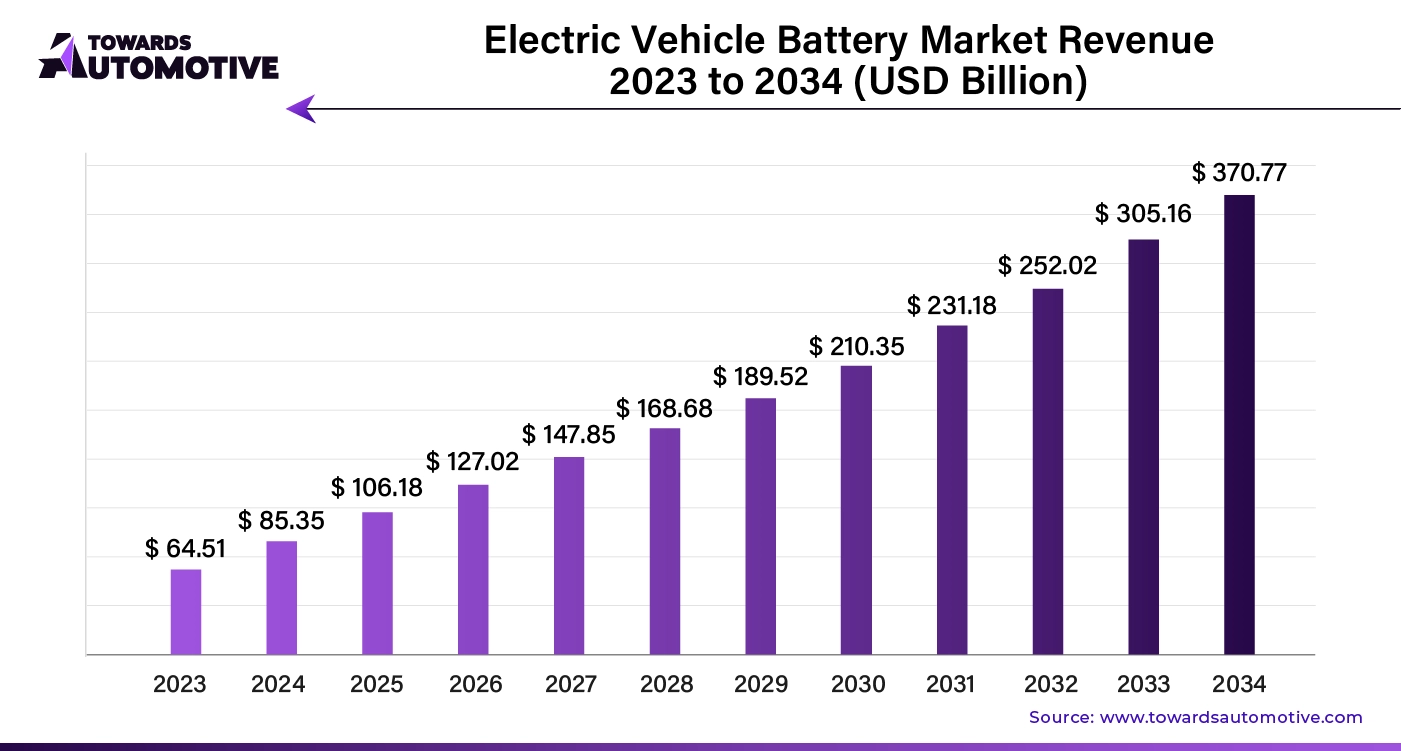
The electric vehicle battery market is experiencing rapid growth, driven by the increasing global adoption of electric vehicles as part of the transition toward cleaner, more sustainable transportation. EV batteries are a critical component of electric vehicles, powering everything from passenger cars to commercial trucks, and their performance directly impacts vehicle range, efficiency, and cost. As governments worldwide implement stricter emissions regulations and provide incentives for EV adoption, the demand for advanced, high-capacity batteries has surged.
The personal segment led the market. The growing popularity of personal electric vehicles among the people of developed nations with an aim at reducing vehicular emission has boosted the market expansion. Additionally, the increasing demand for affordable EVs in developing nations such as India, Vietnam, Thailand and some others is playing a crucial role in shaping the industrial landscape. Moreover, numerous offers and benefits provided by government to individuals for purchasing EVs is expected to foster the growth of the electric vehicles market.
The commercial segment is expected to expand with a significant CAGR during the forecast period. The growing adoption of electric trucks in heavy industries has boosted the market expansion. Additionally, the deployment of EVs by fleet operators for operating ride-sharing services in urban areas is contributing to the industry in a positive direction. Moreover, the increasing emphasis of government for launching electric bus service to provide sustainable transportation solutions is expected to boost the growth of the electric vehicles market.
| Year | Personal | Commercial |
| 2024 | 1086.70 | 457.75 |
| 2025 | 1466.49 | 606.31 |
| 2026 | 1986.38 | 795.53 |
| 2027 | 2639.56 | 1094.04 |
| 2028 | 3548.37 | 1462.50 |
| 2029 | 4780.76 | 1944.33 |
| 2030 | 6428.70 | 2597.05 |
| 2031 | 8654.54 | 3458.92 |
| 2032 | 11645.77 | 4611.70 |
| 2033 | 15767.23 | 6051.91 |
| 2034 | 20969.64 | 8313.83 |
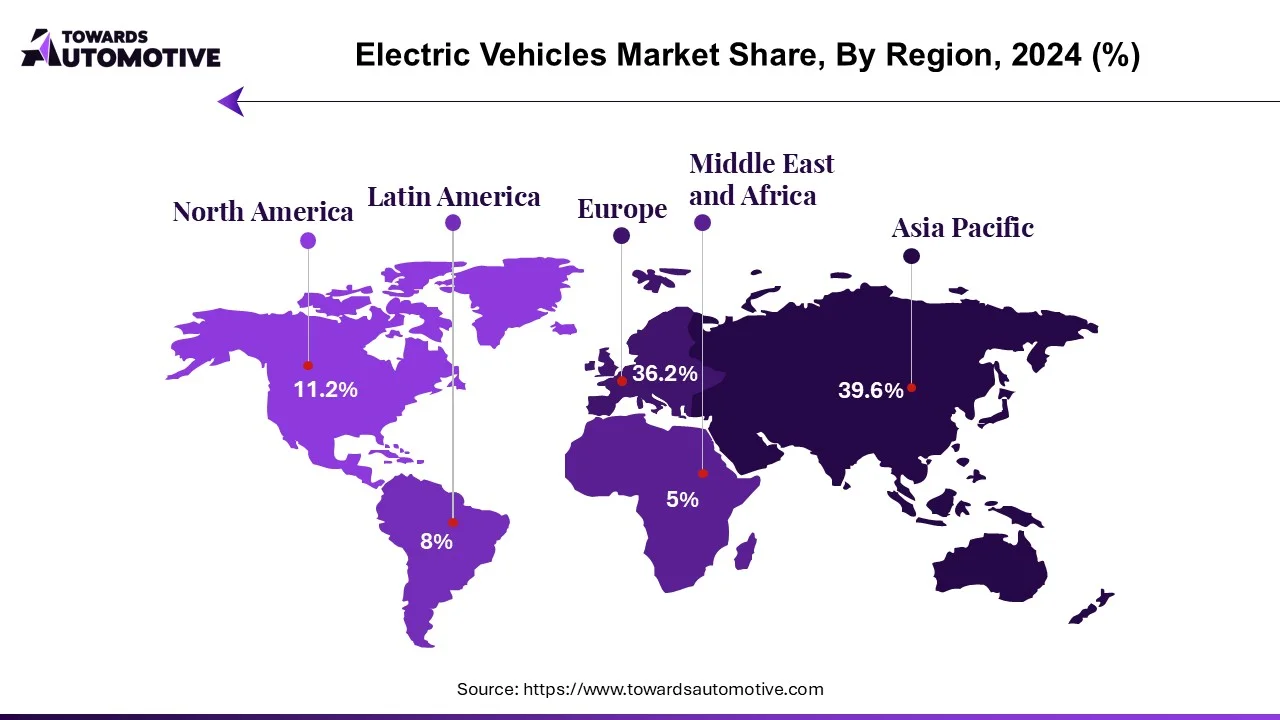
Asia Pacific led the electric vehicles market. The growing adoption of electric vehicles in several countries such as India, China, Japan, South Korea and some others has boosted the market expansion. Additionally, numerous government initiatives aimed at developing the EV charging infrastructure coupled with technological advancements in the battery manufacturing sector is playing a vital role in shaping the industrial landscape. Moreover, the presence of various market players such as BYD, Nissan, Mitsubishi, Odysse and some others is expected to boost the growth of the electric vehicles market in this region.
North America is expected to expand with a significant CAGR during the forecast period. The increasing demand for luxury vehicles in the U.S. and Canada has driven the market growth. Additionally, rapid investment by government for incentivizing EV consumers along with rise in number of startups dealing in EVs is contributing to the industry in a positive direction. Moreover, the presence of numerous market players such as Tesla, Rivian, Ford Motors, General Motors and some others is expected to propel the growth of the electric vehicles market in this region.
| Year | North America | Europe | Asia-Pacific | Latin America | Middle East & Africa |
| 2024 | 308.08 | 336.99 | 602.30 | 135.64 | 161.45 |
| 2025 | 424.91 | 454.59 | 797.99 | 188.45 | 206.87 |
| 2026 | 554.14 | 626.32 | 1078.79 | 261.53 | 261.13 |
| 2027 | 762.89 | 840.72 | 1444.90 | 346.93 | 338.16 |
| 2028 | 1027.54 | 1119.48 | 1934.44 | 449.25 | 480.17 |
| 2029 | 1407.28 | 1463.66 | 2593.69 | 645.62 | 614.84 |
| 2030 | 1889.23 | 1964.75 | 3469.03 | 885.25 | 817.49 |
| 2031 | 2527.72 | 2596.61 | 4677.11 | 1176.61 | 1135.41 |
| 2032 | 3378.09 | 3435.45 | 6323.36 | 1592.93 | 1527.64 |
| 2033 | 4480.07 | 4497.94 | 8383.29 | 2179.58 | 2278.27 |
| 2034 | 5986.13 | 6239.86 | 11332.03 | 2831.54 | 2893.92 |
U.S. Electric Vehicle Market Research, Trends and Forecast
The U.S. electric vehicle market is expected to increase from USD 136.31 billion in 2025 to USD 434.24 billion by 2034, growing at a CAGR of 13.74% throughout the forecast period from 2025 to 2034.
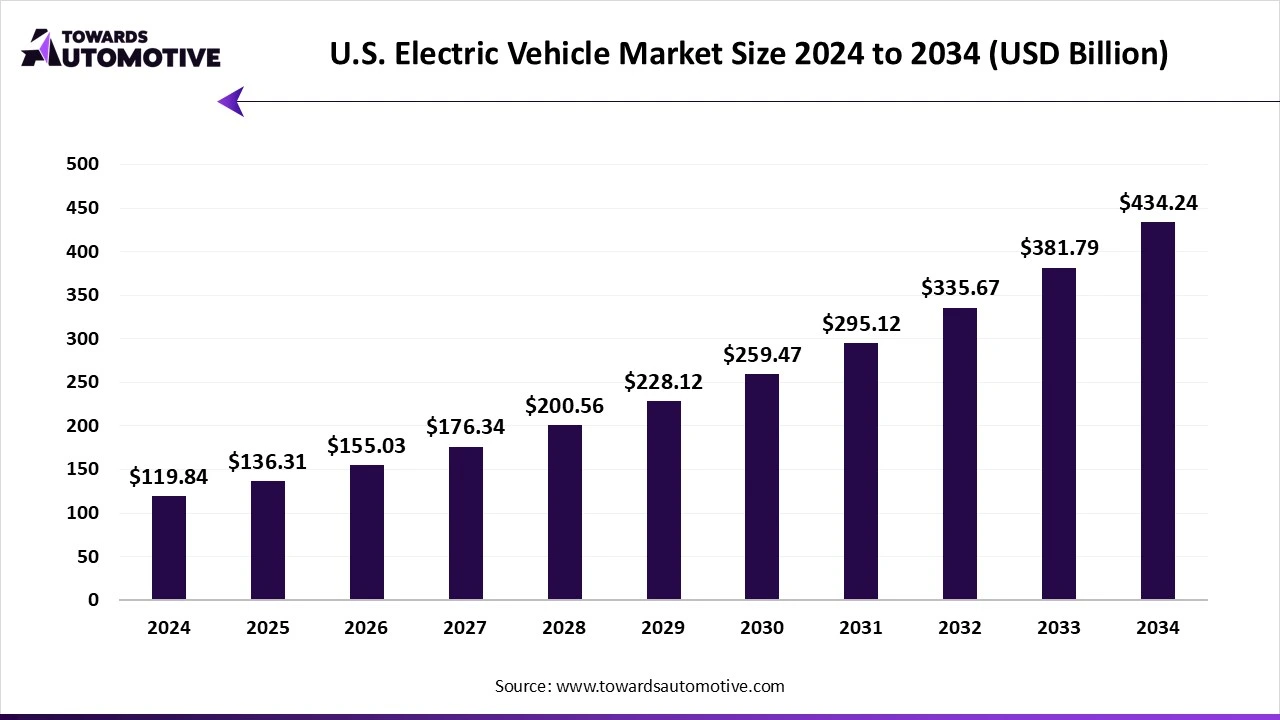
The U.S. electric vehicle market is a crucial segment of the EV industry. This industry deals in manufacturing and distribution of EVs in the U.S. There are different types of vehicles developed in this sector consisting of two-wheelers, passenger cars, commercial vehicles and some others. These vehicles are integrated by various types of drivetrains comprising of front-wheel drive, rear-wheel drive and all-wheel drive. It is powered by numerous batteries including sealed lead acid battery, nickel metal hydride, lithium ion and some others. The rising sales of hybrid vehicles in the U.S. has accelerated the market expansion. This market is predicted to rise significantly with the growth of the automotive sector.
The Europe electric vehicle market is projected to reach USD 6141.22 billion by 2034, expanding from USD 615.19 billion in 2025, at an annual growth rate of 29.13% during the forecast period from 2025 to 2034.
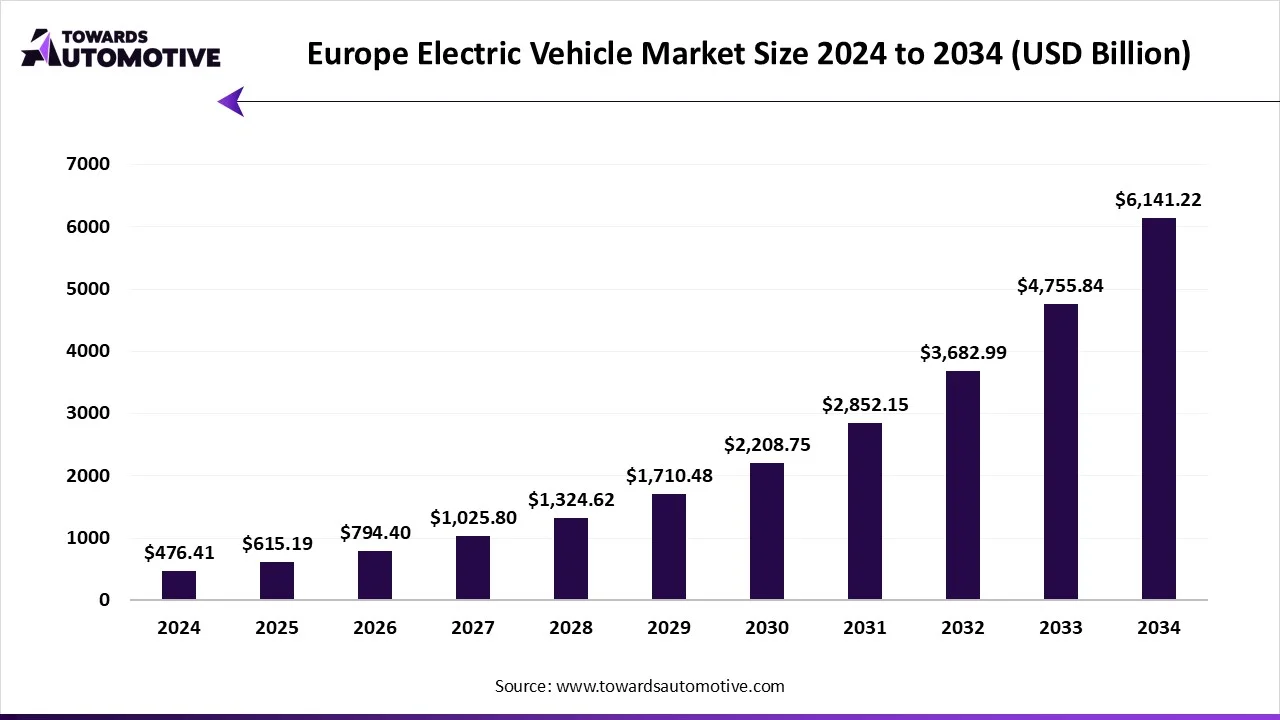
The Europe electric vehicle truck market is a crucial segment of the automotive industry. This industry deals in manufacturing and distribution of EVs in the European region. There are different types of vehicles manufactured in this sector consisting of two-wheelers, passenger cars, commercial vehicles and some others. These vehicles are integrated with various types of drivetrains including front-wheel drive, rear-wheel drive and all-wheel drive. The EVs are powered by numerous types of batteries comprising of sealed lead acid, nickel metal hydride (NiMH), lithium-ion and some others. It finds application in several end-use sectors consisting of personal, commercial, government and private. The growing adoption of EVs due to high prices of gasoline has propelled the industrial expansion. This industry is likely to experience significant rise with the growth of the battery industry across Europe.
The global electric vehicle motor market is anticipated to grow from USD 24.58 billion in 2025 to USD 143.85 billion by 2034, with a compound annual growth rate (CAGR) of 21.69% during the forecast period from 2025 to 2034. The market is driven by the rapid penetration of electric vehicles (EV), government policies to promote EVs, and growing investment by automotive brands.
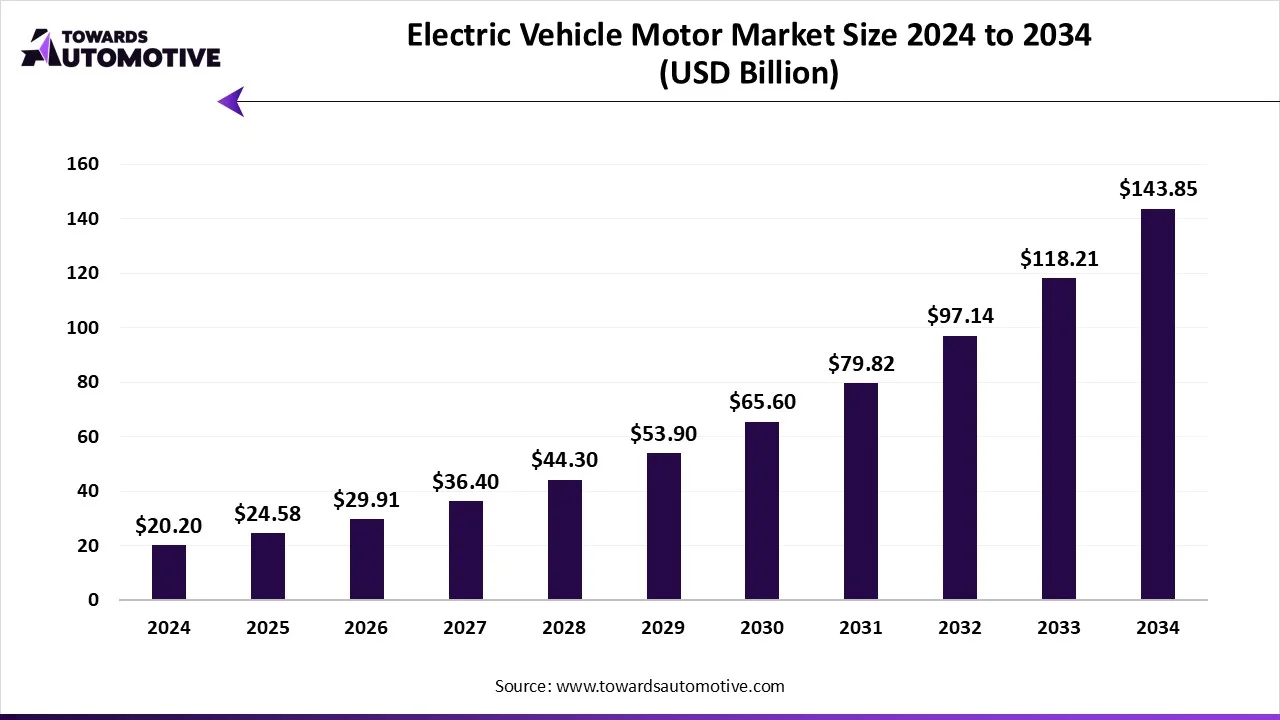
The electric vehicle motor market is experiencing rapid growth due to the rising adoption of electric vehicles globally. As governments implement stringent emission regulations and promote sustainable transportation, the demand for efficient and reliable electric motors for EVs is surging at a rapid pace. The increasing focus on reducing greenhouse gas emissions is driving further innovation in electric motor designs. These innovations include improvements in efficiency, power density, and thermal management.
The electric vehicle taxi market is projected to reach USD 80.77 billion by 2034, growing from USD 27.69 billion in 2025, at a CAGR of 12.63% during the forecast period from 2025 to 2034.
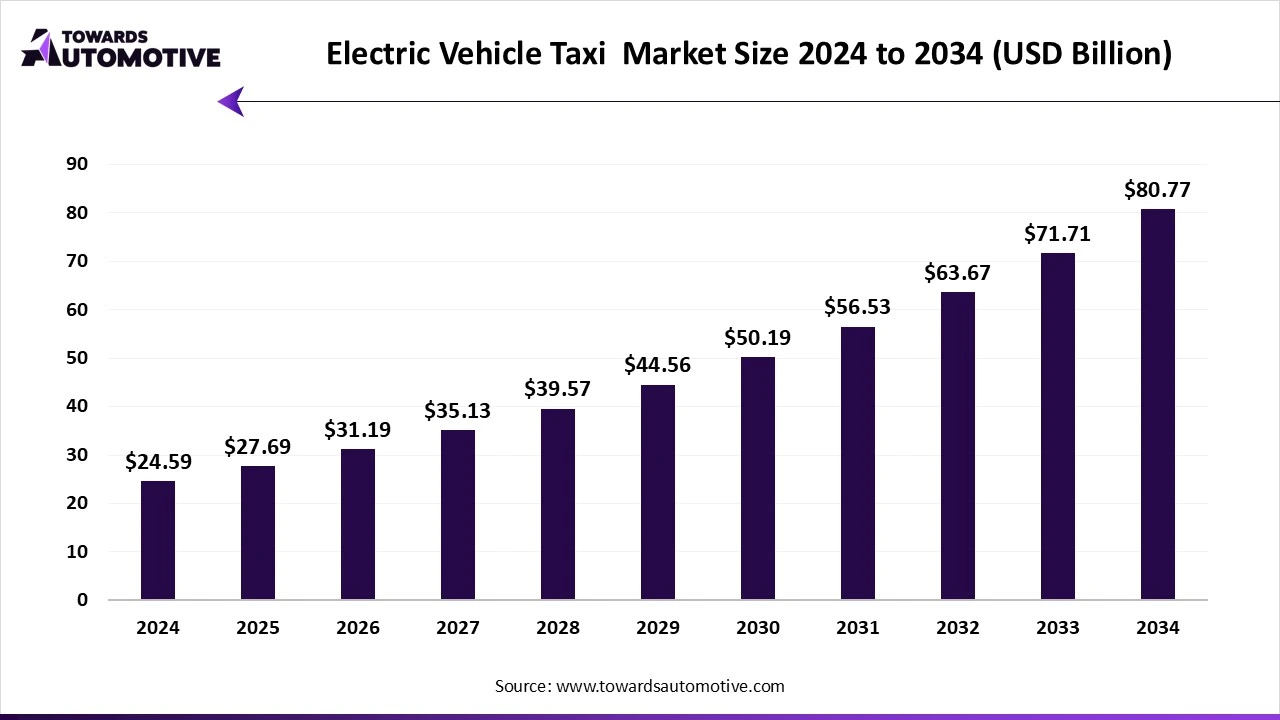
The electric vehicle taxi market is a prominent segment of the EV industry. This industry deals in providing taxi services based on electric vehicles across the world. There are several types of vehicles used in this sector consisting of battery electric vehicles (BEVs), hybrid electric vehicles (HEVs), plug-in hybrid electric vehicles (PHEVs) and some others. This sector provides different types of taxis including short-range taxis and long-range taxis. The rising sales of electric vehicles in different parts of the world has driven the market expansion. This industry is expected to rise significantly with the growth of the ride-hailing services sector in different parts of the globe.
The semiconductor devices for electric vehicle market is set to grow from USD 13.47 billion in 2025 to USD 44.08 billion by 2034, with an expected CAGR of 14.08% over the forecast period from 2025 to 2034.
![]()
The semiconductor devices for electric vehicle market is a crucial branch of the automotive industry. This market deals in manufacturing and development of semiconductor devices for electric vehicles. There are several types of devices manufactured in this sector consisting of power semiconductor devices, analog semiconductor devices, digital semiconductor devices, MEMS sensors, microcontrollers and some others. It finds various application in powertrain, battery management systems, infotainment systems, driver assistance systems, body control systems and some others. This sector uses different types of semiconductors consisting of silicon, silicon carbide, gallium nitride, mixed-signal technology and analog technology. The growing development in the semiconductor industry has boosted the industrial expansion. This market is expected to rise significantly with the growth of the electric vehicles industry around the globe.
The electric vehicle (EV) charger market size is forecasted to expand from USD 18.94 billion in 2025 to USD 175.16 billion by 2034, growing at a CAGR of 28.04% from 2025 to 2034.
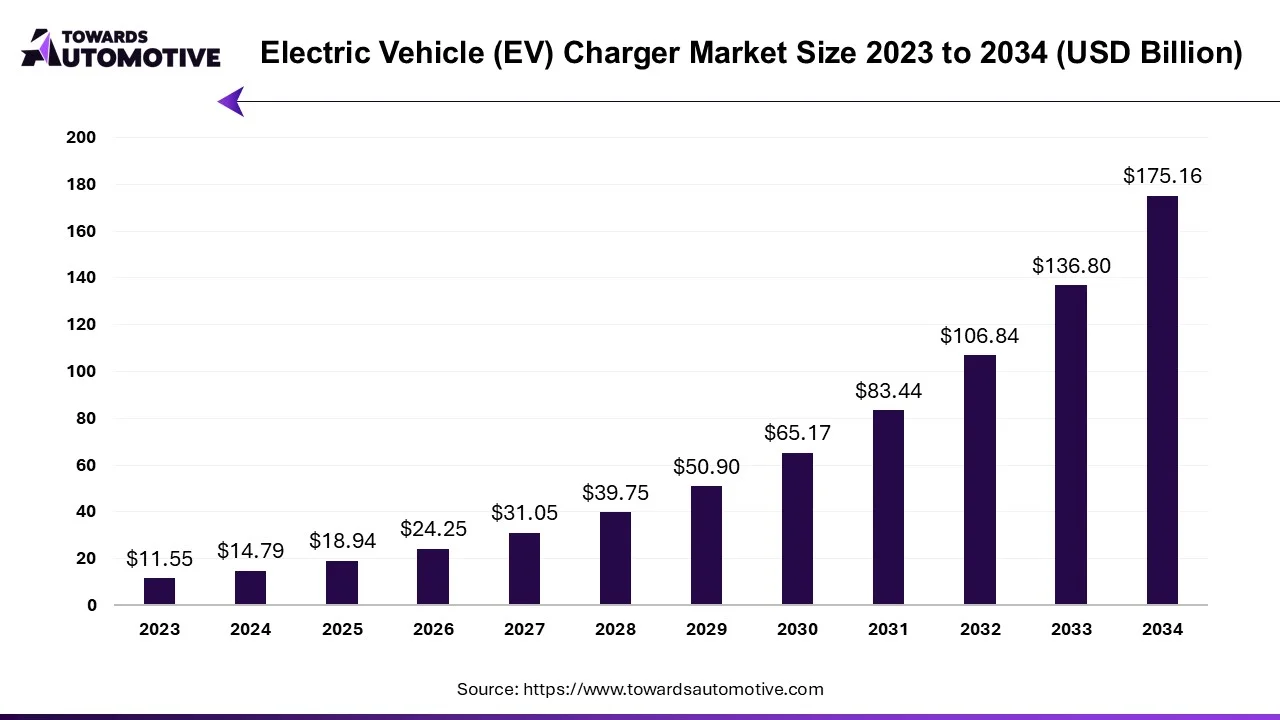
The electric vehicle (EV) charger market is a crucial branch of the electric vehicles industry. This industry deals in development and distribution of EV chargers across the globe. There are different types of chargers available in the market comprising of on-board charger and off-board charger. These chargers are designed for charging various types of vehicles including plug-in hybrid vehicle (PHEV), battery electric vehicle (BEV), hybrid electric vehicle (HEV). The end-users of these chargers consist of commercial users and residential users. The rise in number of EV charging stations in different parts of the world has boosted the industrial expansion. This market is expected to rise significantly with the growth of the automotive industry around the world.
The global off-highway electric vehicle market size is calculated at USD 2.58 billion in 2024 and is expected to be worth USD 9.69 billion by 2034, expanding at a CAGR of 14.15% from 2024 to 2034.
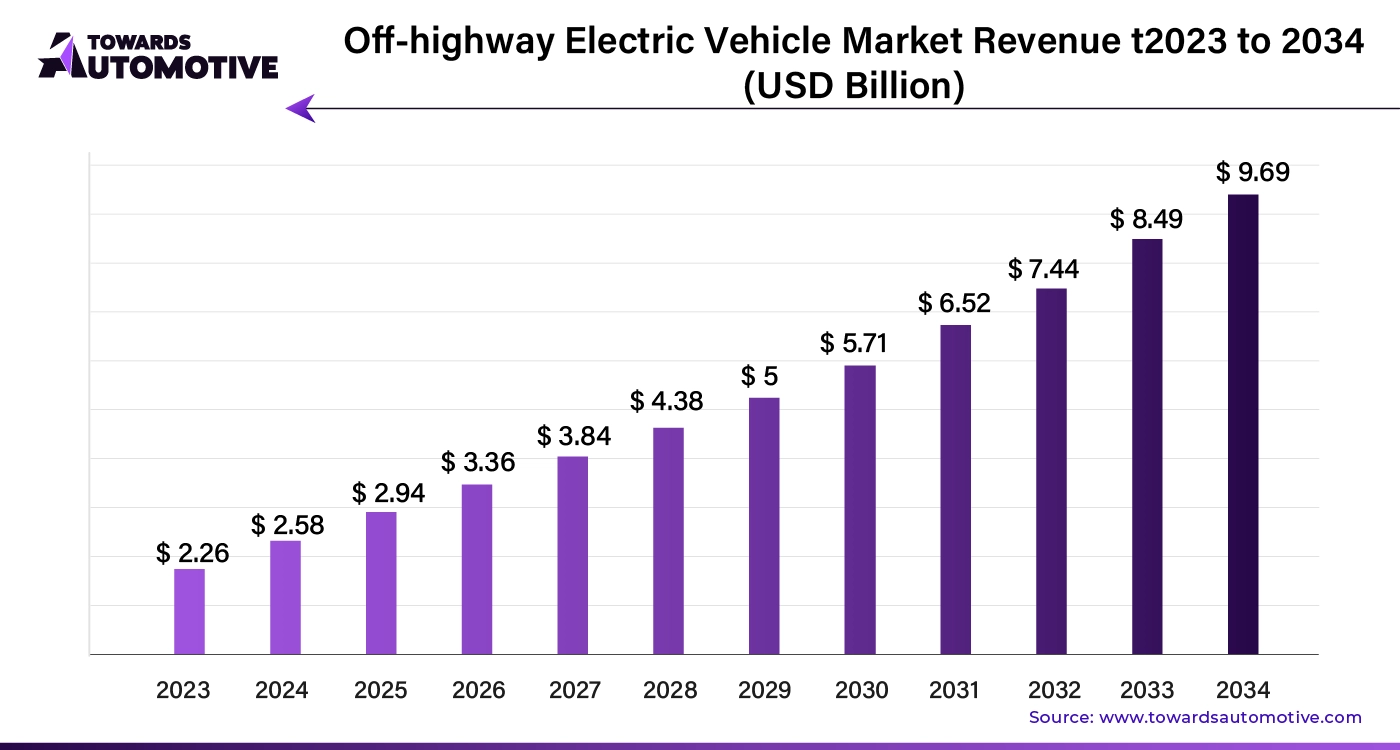
The off-highway electric vehicle market is experiencing rapid growth as industries such as construction, mining, agriculture, and forestry increasingly prioritize sustainability and operational efficiency. Off-highway electric vehicles, including electric excavators, loaders, and tractors, offer significant environmental benefits by reducing carbon emissions, noise pollution, and fuel dependency. With growing global awareness of environmental concerns and stringent emissions regulations, companies are transitioning from traditional diesel-powered machines to electric alternatives, which provide both environmental and cost-saving advantages.
The global electric vehicle insulation market size is calculated at USD 7.48 billion in 2024 and is expected to reach around USD 43.02 billion by 2034, growing at a CAGR of 21.74% from 2024 to 2034.
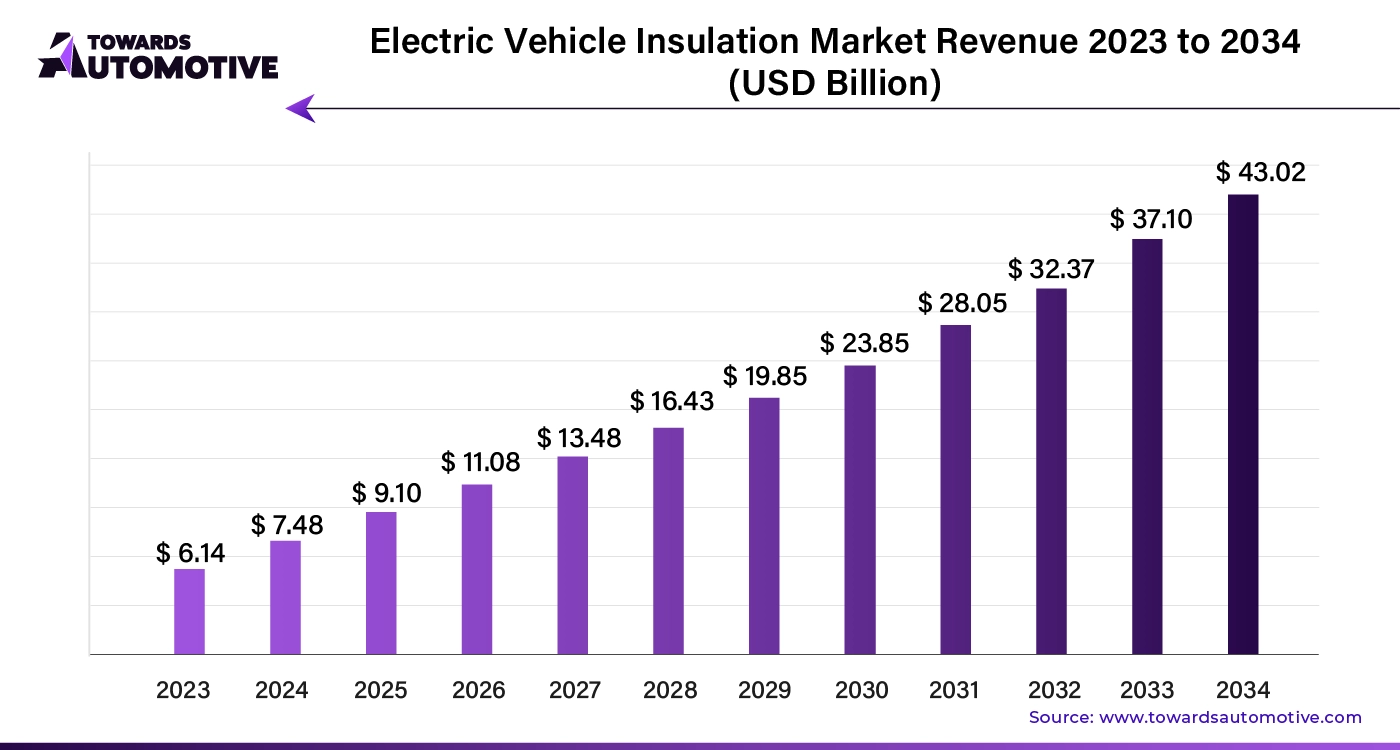
The electric vehicle (EV) insulation market is a crucial segment within the rapidly expanding EV industry, addressing key challenges in thermal management, energy efficiency, and noise reduction. As electric vehicles are gaining popularity due to environmental regulations and consumer demand for sustainable transportation, the importance of high-performance insulation materials has grown significantly. These materials help to manage battery temperatures, ensuring optimal performance and safety along with reducing energy loss and improving vehicle efficiency.
Additionally, insulation solutions contribute to enhancing passenger comfort by minimizing noise, vibration, and harshness (NVH). With advancements in insulation technologies and the increase in EV production, the market is poised for robust growth. Companies are focusing on developing lightweight, durable, and highly effective insulation materials to meet the evolving needs of EV manufacturers. Government incentives for EV adoption, along with the ongoing push for energy-efficient and eco-friendly vehicles, are expected to further drive demand in this market over the coming years.
The global electric vehicle battery housing market size is calculated at USD 2.02 billion in 2024 and is expected to reach around USD 31.27 billion by 2034, growing at a CAGR of 31.84% from 2024 to 2034.
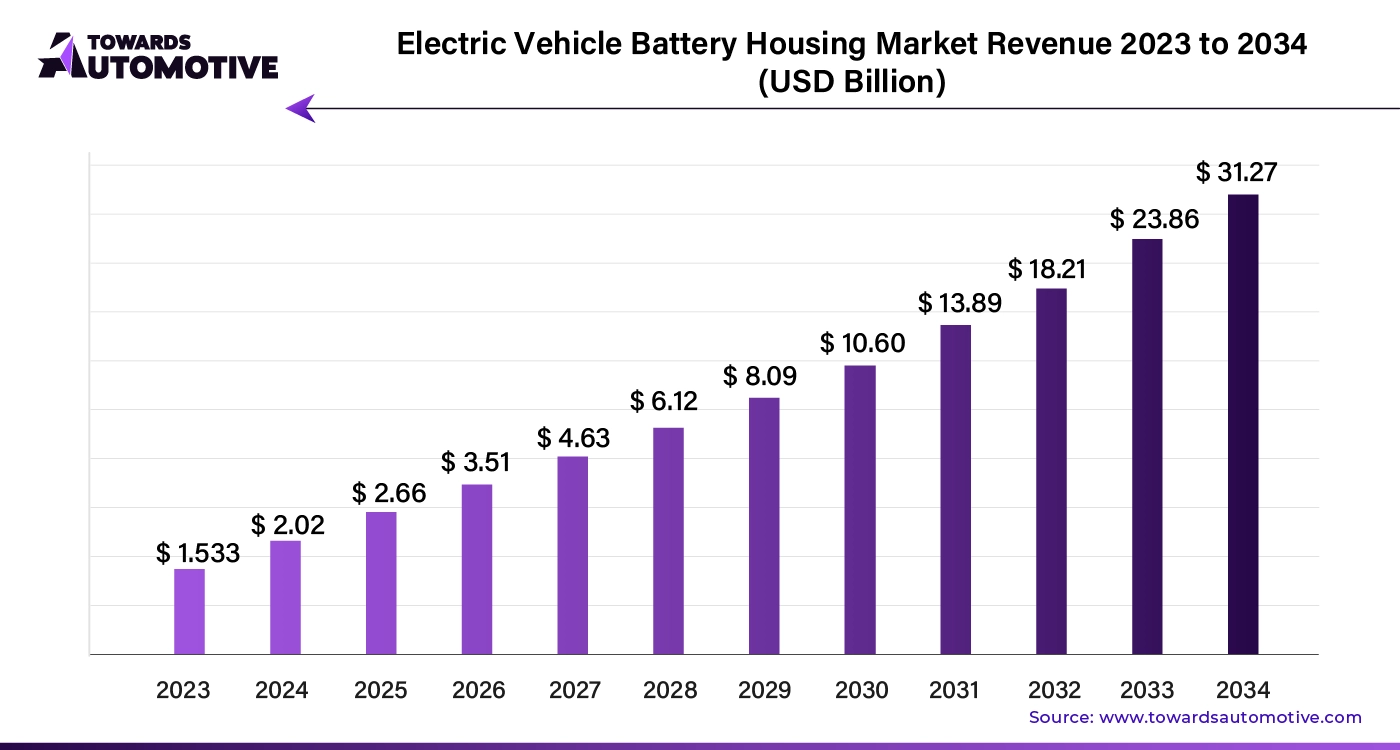
The electric vehicle battery housing market is expanding rapidly as the global shift toward sustainable transportation accelerates. Battery housing units play a crucial role in protecting and optimizing the performance of EV batteries, which are essential for powering electric drivetrains. These housings are designed to provide structural support, thermal management, and safety for battery packs, ensuring that they operate efficiently and reliably under various conditions. As electric vehicles gain popularity due to environmental regulations and consumer demand for greener alternatives, the need for advanced battery housing solutions grows.
The electric vehicle fluid market is projected to reach USD 25.84 billion by 2034, expanding from USD 2.17 billion in 2025, at an annual growth rate of 31.80% during the forecast period from 2025 to 2034. The growing investment by automotive companies to manufacture several types of electric vehicles coupled with numerous government initiatives aimed at adopting EVs has boosted the market expansion.
Additionally, rapid growth in the petrochemicals industry along with technological advancements in the EV manufacturing sector is playing a prominent role in shaping the industrial landscape. The research and development activities related to bio-based EV fluids is expected to create ample growth opportunities for the market players in the upcoming years to come.
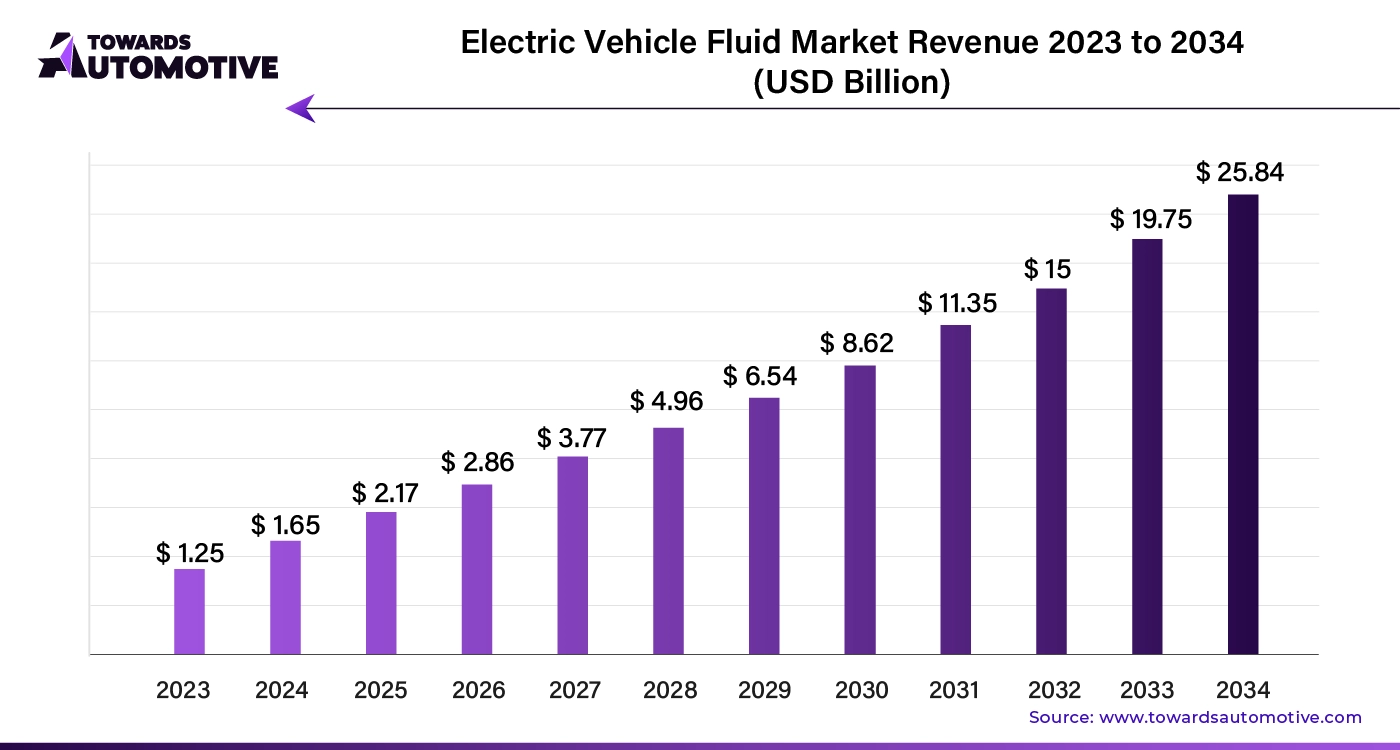
The electric vehicle fluid market is a crucial sector of the automotive industry. This industry deals in manufacturing and distribution of different types of fluid for the EV sector. There are several types of fluids developed in this sector comprising of engine oil, coolant, transmission fluids and some others. These fluids are designed for different types of vehicles consisting of battery electric vehicles and hybrid electric vehicles. The increasing demand for electric vehicles in different parts of the world has contributed to the industrial growth. This market is expected to rise significantly with the growth of the oil and gas industry across the world.
The global light electric vehicle market is forecast to grow from USD 108.77 billion in 2025 to USD 243.85 billion by 2034, driven by a CAGR of 10.63% from 2025 to 2034.
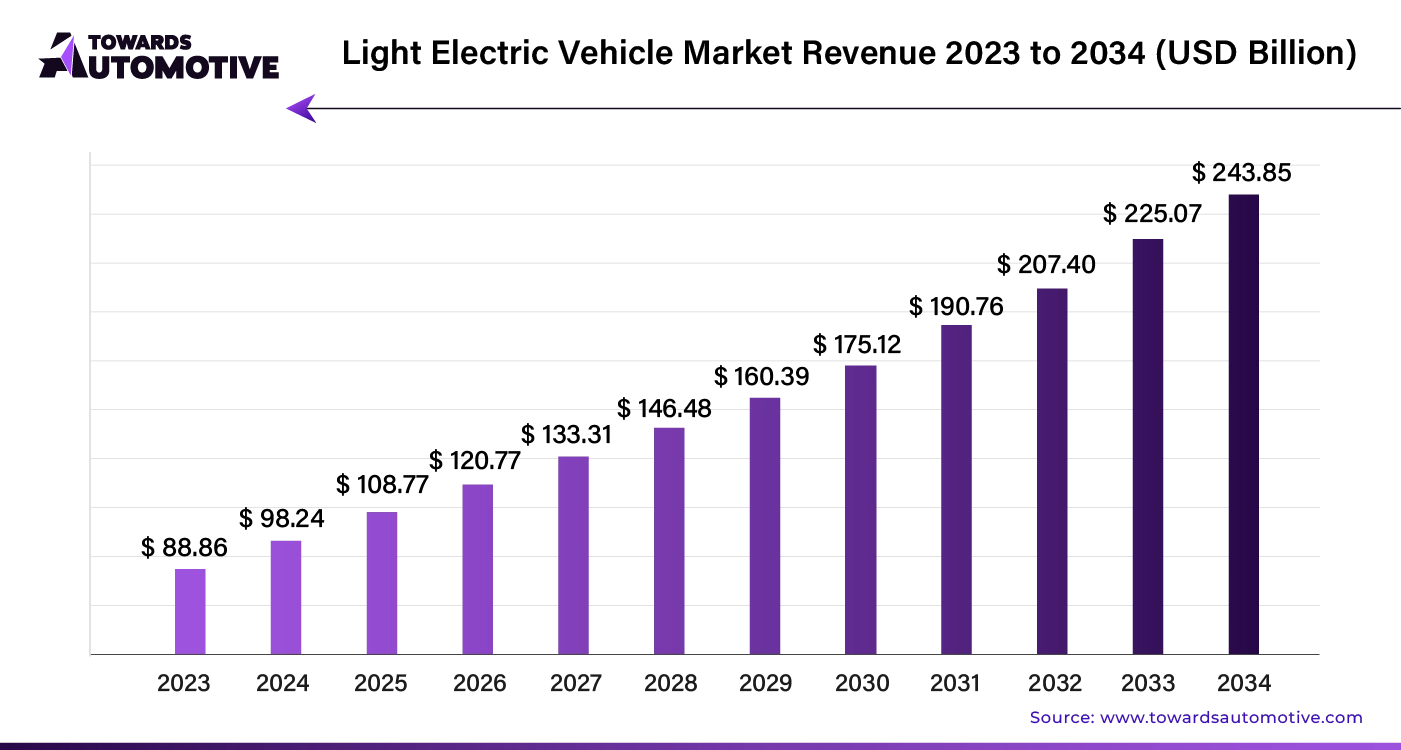
The Light Electric Vehicle (LEV) market is expanding rapidly due to increasing air pollution and a growing demand for clean transportation. LEVs, such as electric bicycles and scooters, are becoming popular in cities facing severe pollution, offering a sustainable alternative to traditional gasoline-powered vehicles.
The surge in eCommerce and the need for efficient last-mile delivery services are also boosting the market. Electric bikes and scooters provide a practical and cost-effective solution for quick deliveries. The automotive market valued at USD 4,070.19 billion in 2023, is experiencing growth and is projected to surpass USD 6,678.28 billion by 2032, with a significant CAGR of over 5.66%.
The global plug-in hybrid electric vehicle market size is calculated at USD 36.62 billion in 2024 and is expected to be worth USD 193.80 billion by 2034, expanding at a CAGR of 18.3% from 2023 to 2034.
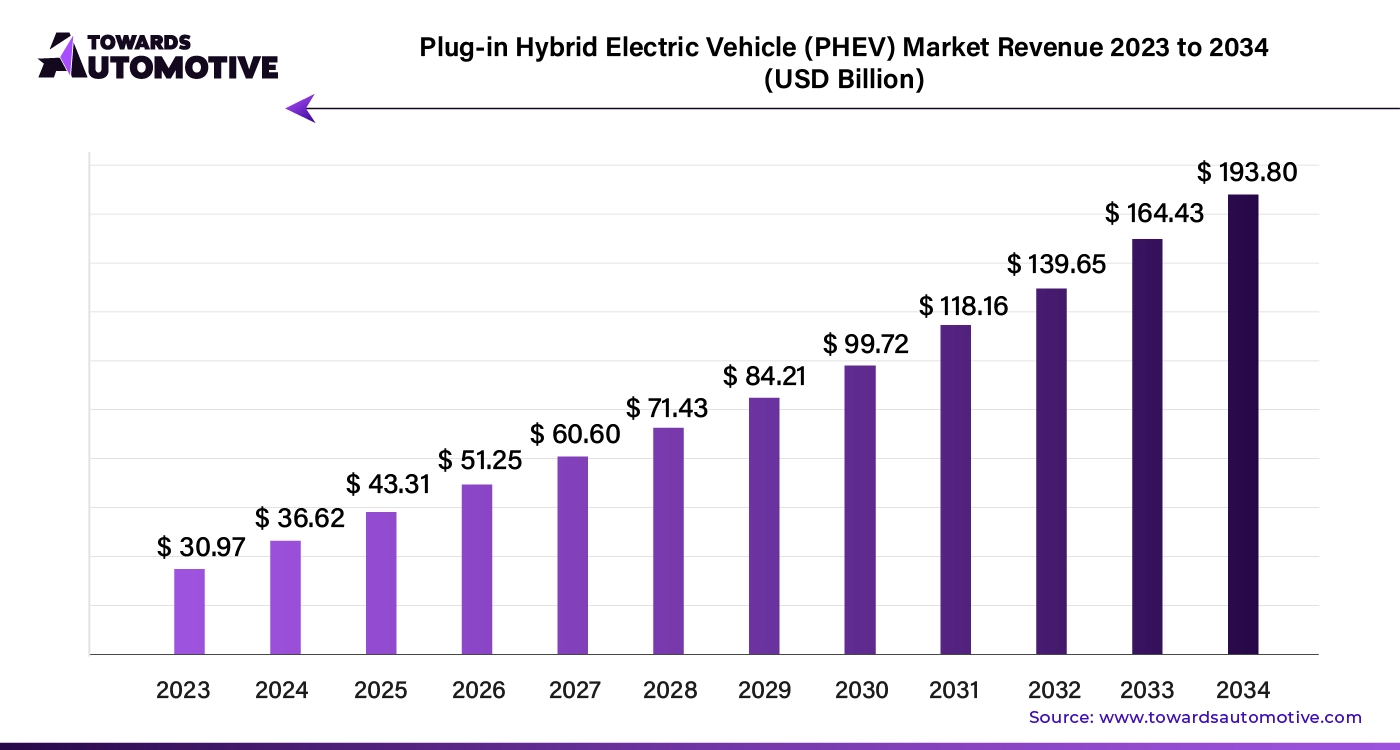
As governments tighten regulations on greenhouse gas emissions, the push for plug-in hybrid electric vehicles (PHEVs) is gaining momentum. Consumers are increasingly aware of their carbon footprints and are seeking more sustainable transportation options. PHEVs offer an attractive solution, combining the benefits of electric and traditional fuel combustion engines. This hybrid approach significantly reduces emissions and dependence on fossil fuels, making it a compelling choice for eco-conscious drivers.
The electric vehicle sensor market is expected to increase from USD 12.53 billion in 2025 to USD 50.98 billion by 2034, growing at a CAGR of 16.87% throughout the forecast period from 2025 to 2034. The increasing sales of EVs in developed nations for lowering emission coupled with numerous government initiatives aimed at developing the EV industry has driven the market expansion.
Additionally, rapid investment by EV brands for integrating advanced sensors in vehicles to monitor EV performance along with advancements in sensor technology is playing a vital role in shaping the industrial landscape. The research and development activities related to solid-state batteries is expected to create ample growth opportunities for the market players in the upcoming years.
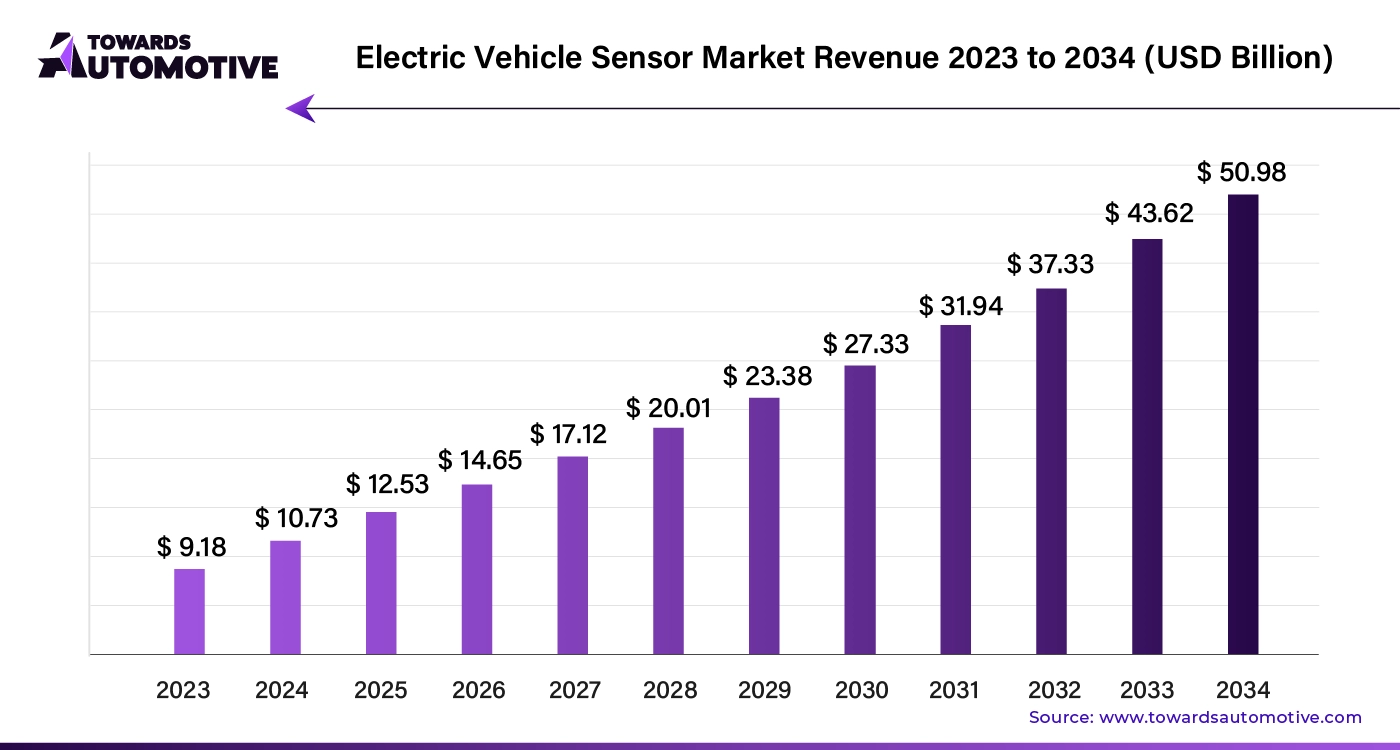
The electric vehicle sensor market is a prominent sector of the automotive industry. This industry deals in manufacturing and distribution of EV sensors around the world. There are numerous types of sensors developed in this sector comprising of temperature sensors, current/voltage sensors, position sensors, speed sensors, Lidar sensors, radar sensors and some others. It is used in various types of vehicles including passenger cars and commercial vehicles. These vehicles are powered by different propulsion technology consisting of BEV and HV. This market is expected to rise significantly with the growth of the EV sector in different parts of the globe.
The electric vehicle maintenance market is expected to increase from USD 24.08 billion in 2025 to USD 84.84 billion by 2034, growing at a CAGR of 15.9% throughout the forecast period from 2025 to 2034.

As the number of electric vehicles (EVs) on the road continues to increase, so does the need for effective maintenance solutions. This surge in EV sales presents a significant opportunity for vendors in the automotive maintenance industry. Government initiatives and growing environmental awareness are driving this adoption, fueling the demand for specialized services.
Electric vehicles, while eco-friendly, present unique maintenance challenges. Studies indicate that EVs experience 79% more maintenance issues compared to traditional gasoline-powered cars. This discrepancy underscores a considerable market opportunity for service providers who can cater to the needs of a burgeoning fleet of electric vehicles.
The shift from gasoline to electric power introduces a new paradigm for vehicle owners. Many consumers are unfamiliar with the specific maintenance requirements of EVs and are therefore more likely to seek out professional services rather than relying on DIY methods or amateur help. Professional service providers are capitalizing on this by showcasing their expertise and specialized capabilities, thereby attracting a growing customer base.
The electric vehicle finance market is predicted to expand from USD 71.39 billion in 2025 to USD 902.90 billion by 2034, growing at a CAGR of 32.57% during the forecast period from 2025 to 2034. The growing sales of EVs in developed nations to curb emission coupled with technological advancements in the BFSI sector is playing a vital role in shaping the industry in a positive direction.
Additionally, the rise in number of EV startups along with numerous government initiatives aimed at providing flexible EMI options to EV consumers has contributed to the market expansion. The rising emphasis on developing the EV charging infrastructure is expected to create ample growth opportunities for the market players in the upcoming years to come.
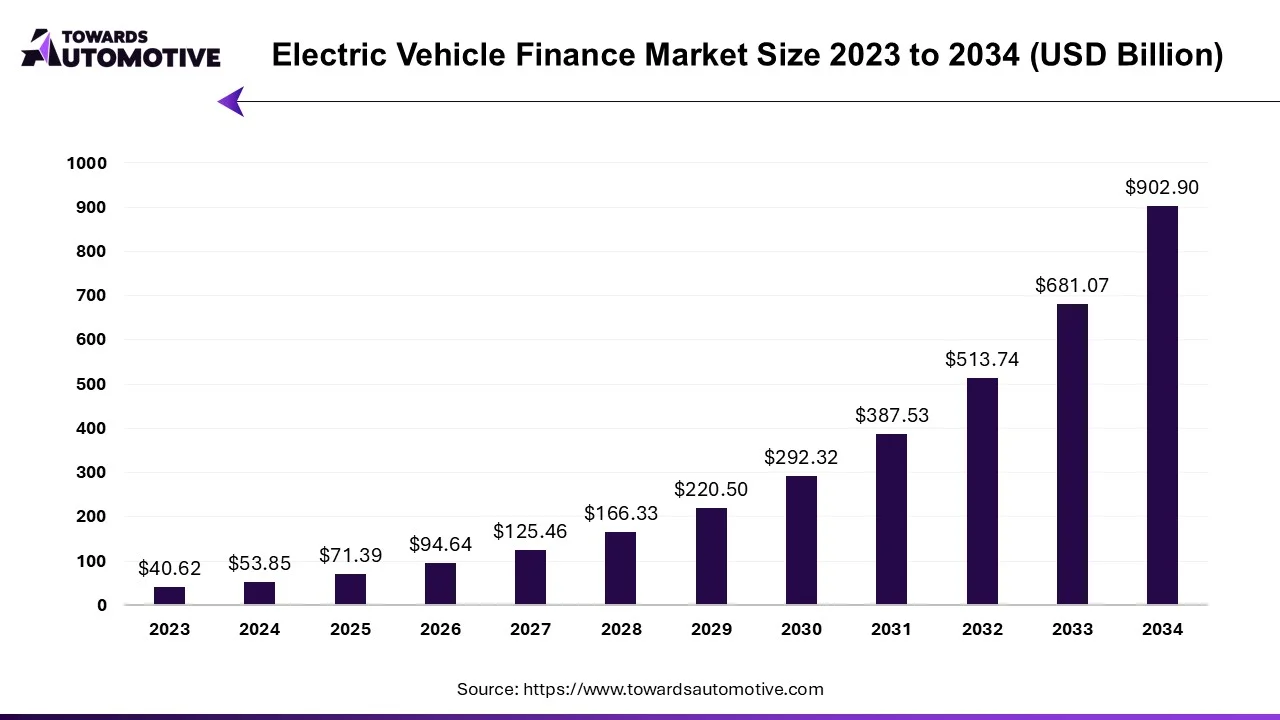
The electric vehicle finance market is a crucial segment of the BFSI industry. This industry deals in providing loans for purchasing EVs in different parts of the world. These loans are provided by different types of financial institutions including banks, NBFCs and some others. The EV loans are designed for purchasing numerous types of vehicles consisting of passenger cars, commercial vehicles, two-wheelers and three-wheelers. There are several types of finances delivered by this sector comprising of leasing, loans, rent-to-own and some others. The growing adoption of eco-friendly vehicles in different parts of the world has played a crucial role in shaping the industrial landscape. This market is expected to rise significantly with the growth of the automotive sector around the globe.
The electric vehicle charging station market is forecast to grow at a CAGR of 19.18%, from USD 45.59 billion in 2025 to USD 221.18 billion by 2034, over the forecast period from 2025 to 2034. The growing adoption of electric vehicles in Western nations to reduce vehicular emission coupled with numerous government initiatives aimed at developing the EV charging infrastructure has boosted the market expansion.
Additionally, rapid investment by startup companies to construct new EV charging stations along with technological advancements in the EV sector is playing a vital role in shaping the industrial landscape. The research and development activities related to wireless EV charging is expected to create ample growth opportunities for the market players in the years to come.
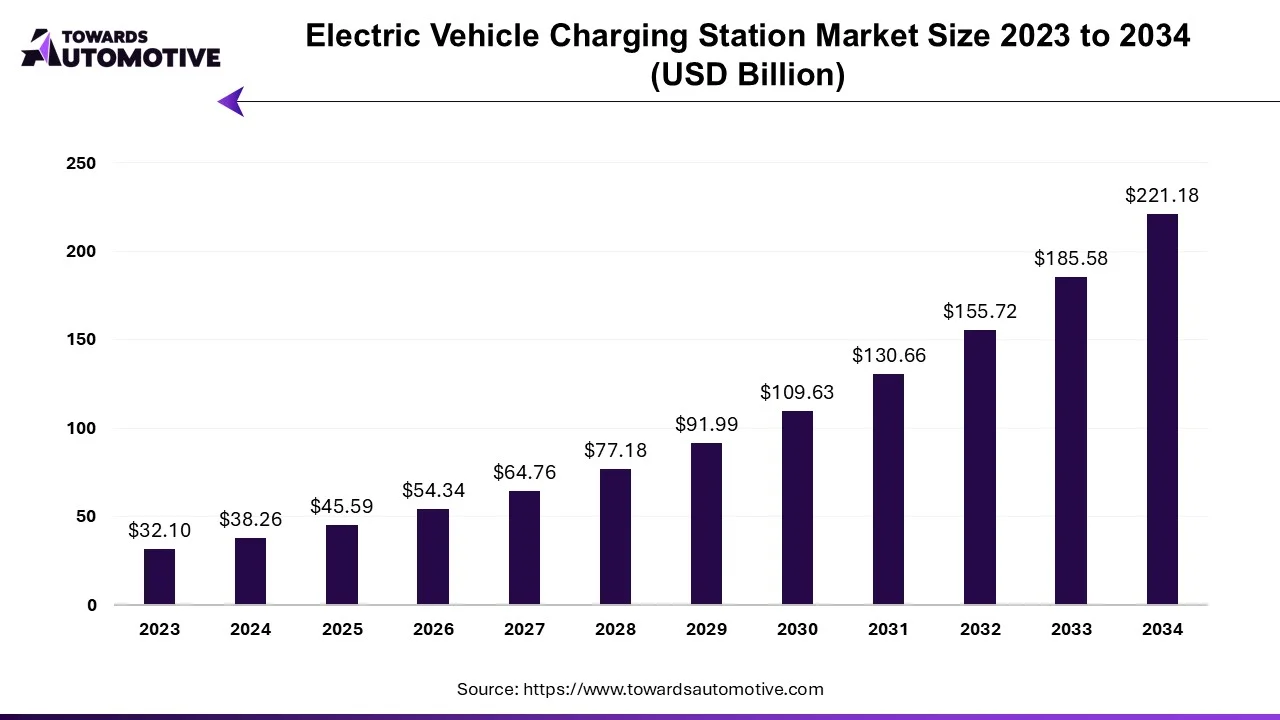
The electric vehicle charging station market is a prominent sector of the EV industry. This industry deals in deploying EV charging stations across the world. There are different types of EV charging stations deployed by this sector including AC charging station, DC charging station, wireless charging stations and some others. These charging stations supports numerous levels of charging consisting of level 1 charging, level 2 charging and level 3 charging. The end-user of this sector comprises of commercial EV charging stations and residential EV charging stations. This market is expected to rise significantly with the growth of the automotive sector around the globe.
The fuel cell electric vehicle market is forecast to grow at a CAGR of 21.40%, from USD 3.09 billion in 2025 to USD 17.73 billion by 2034, over the forecast period from 2025 to 2034.
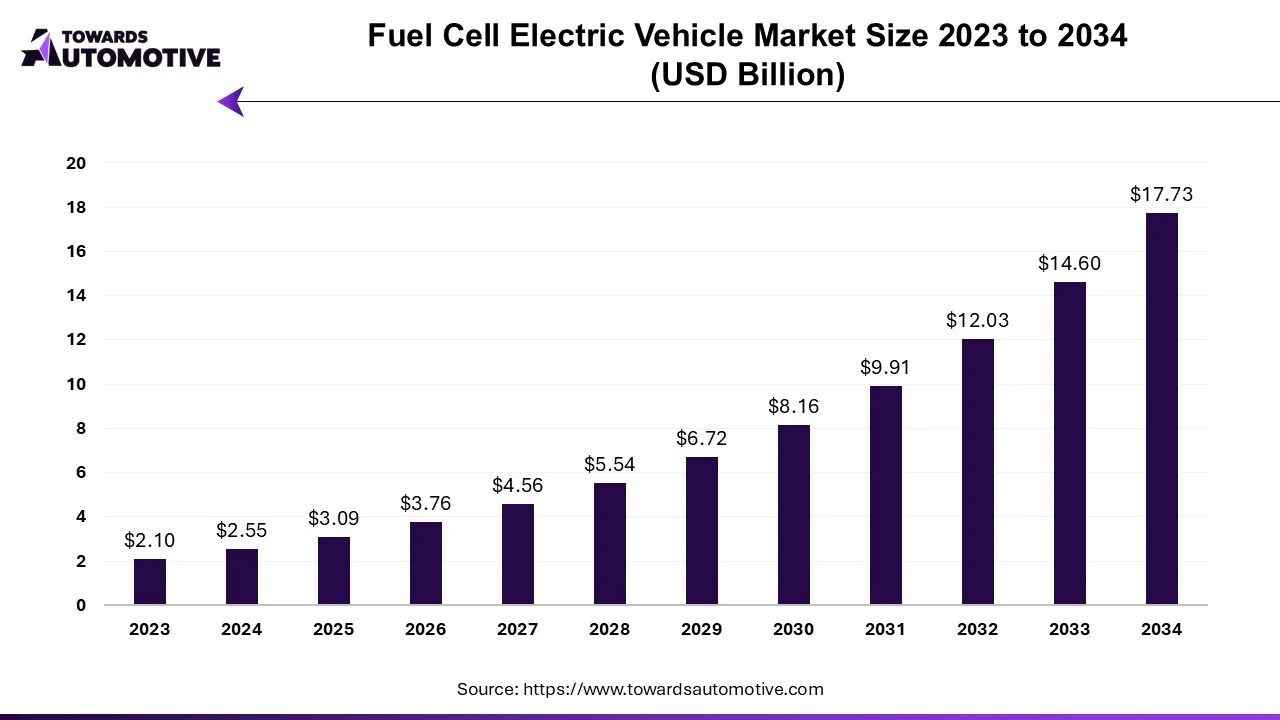
The challenges posed by climate change; renewable energy has emerged as a critical component of the global energy landscape. Governments worldwide are enacting favorable regulations, offering subsidies, and providing tax incentives to incentivize entrepreneurs to engage in renewable energy production. This concerted effort aims to stimulate investment in sustainable energy sources and drive economic growth.
Moreover, pollution reduction initiatives and stringent government regulations are pushing companies to curb carbon emissions and enhance vehicle fuel efficiency. As a result, manufacturers are increasingly turning their focus towards developing vehicles powered by Fuel Cell Electric Vehicles (FCEVs). These vehicles utilize hydrogen fuel cells to produce electricity, emitting only water vapor as a byproduct, thus offering a clean and environmentally friendly transportation solution.
The automotive cybersecurity market is set to grow from USD 4.91 billion in 2025 to USD 17.51 billion by 2034, with an expected CAGR of 15.14% over the forecast period from 2025 to 2034. The rising cases of phishing attacks in modern cars coupled with technological advancements in the automotive sector is playing a vital role in shaping the industrial landscape.
Moreover, the increasing adoption of cloud-based cyber security solutions by automotive companies along with ongoing trend of connected vehicles has contributed to the market expansion. The integration of AI and IoT in cyber security solutions as well as rising complexities in vehicle infrastructure is expected to create ample growth opportunities for the market players in the future.
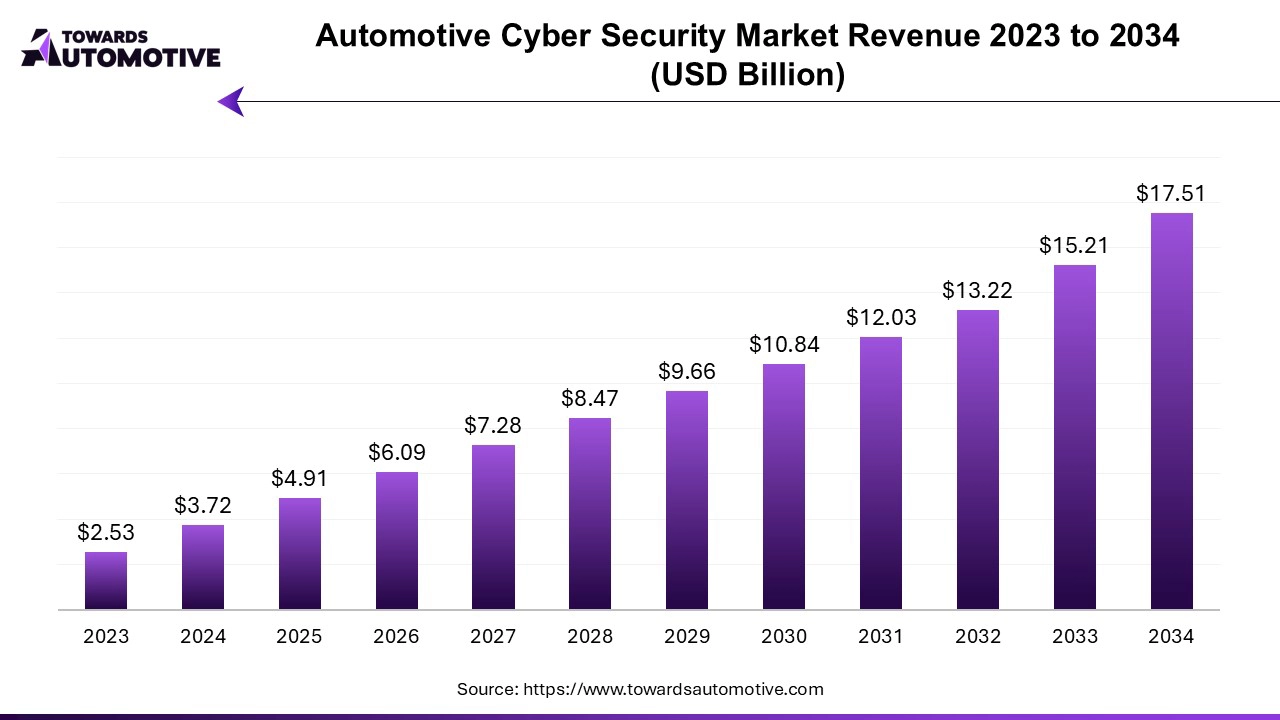
The automotive cyber security market is a crucial branch of the automotive industry. This industry deals in developing and distributing cyber security solutions for the automotive sector. There are different types of cybersecurity solutions delivered by this sector comprising of in-vehicle cybersecurity and external cloud security. These solutions are designed for numerous types of vehicles including passenger vehicles and commercial vehicles. It finds application in various automotive systems consisting of ADAS & safety, body control & comfort, infotainment, telematics, powertrain systems, communication systems and some others. The growing number of hackers in western nations has boosted the market expansion. This market is expected to rise significantly with the rise of the software industry in different parts of the world.
The electric vehicle aftermarket is projected to reach USD 351.59 billion by 2034, growing from USD 84.08 billion in 2025, at a CAGR of 17.23% during the forecast period from 2025 to 2034.
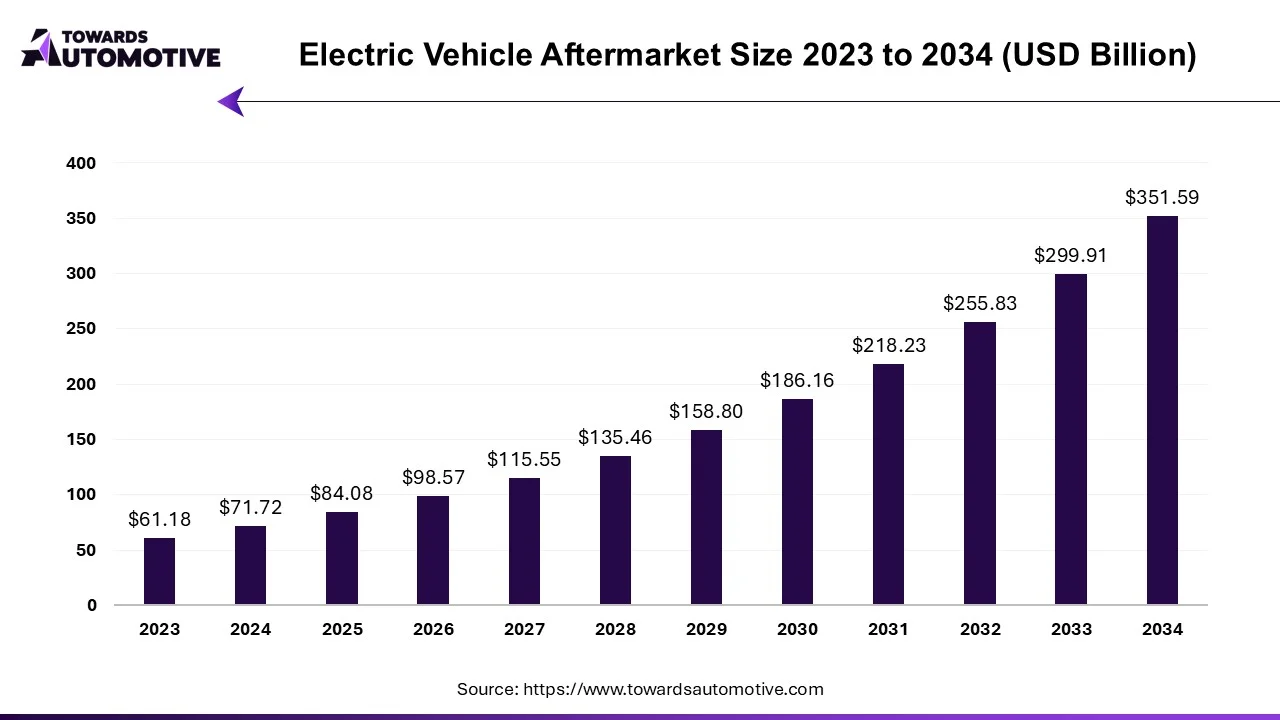
The burgeoning growth of electric vehicle (EV) batteries stands as a driving force propelling the expansion of the electric vehicle aftermarket market. As the EV market continues to surge, the customer base for repair, maintenance, and customization services expands in tandem. With an increasing number of electric cars hitting the roads, the demand for after-sales services escalates, necessitating advanced support tailored to the unique needs of EV owners. Key services include battery replacement, charging infrastructure installation, and software upgrades, all of which play pivotal roles in ensuring the continued performance and longevity of electric vehicles.
The electric vehicle (EV) charging management software platform market is forecasted to expand from USD 1.36 billion in 2025 to USD 8.35 billion by 2034, growing at a CAGR of 22.33% from 2025 to 2034.
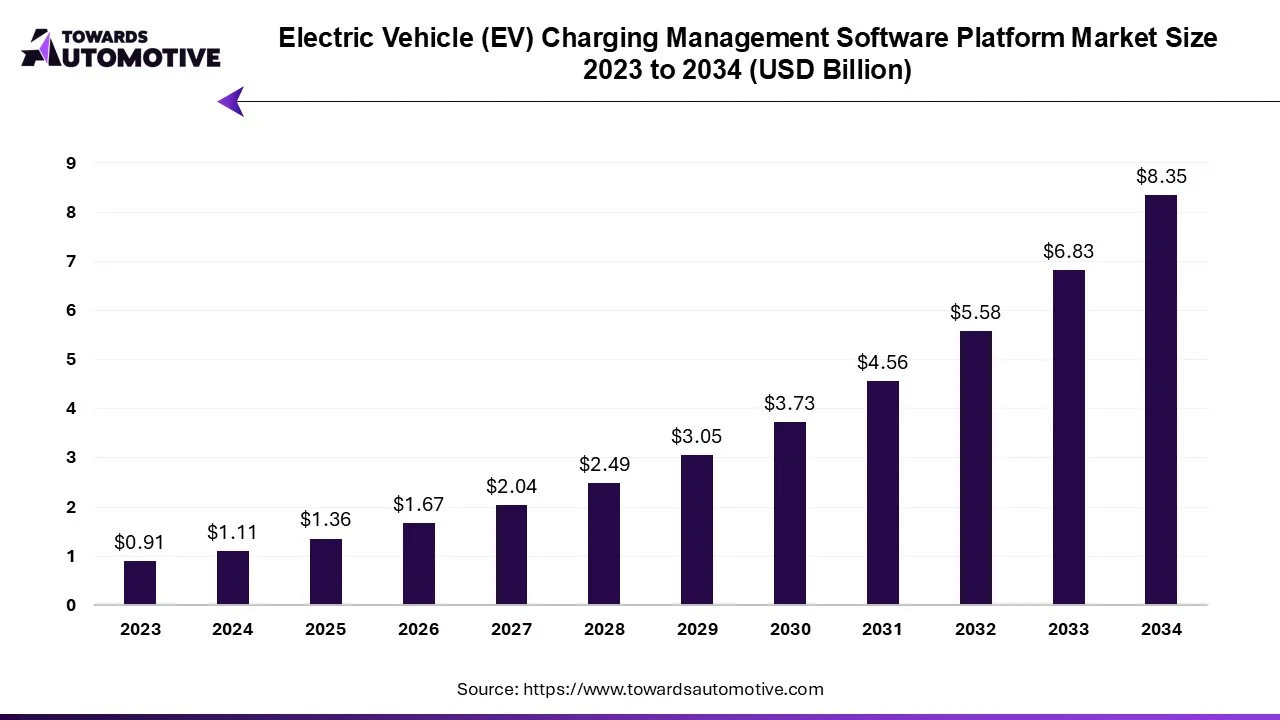
The EV charging management software platform market is experiencing robust growth and is expected to expand significantly in the coming years, driven by the rapid adoption of electric vehicles worldwide and the growing need for efficient charging infrastructure. With the increasing demand for clean and sustainable transportation solutions, governments, businesses, and consumers are investing in electric vehicles and charging infrastructure, creating a favorable environment for the growth of the EV charging management software platform market.
The luxury electric vehicle market is forecasted to expand from USD 224.61 billion in 2025 to USD 625.38 billion by 2034, growing at a CAGR of 12.05% from 2025 to 2034.
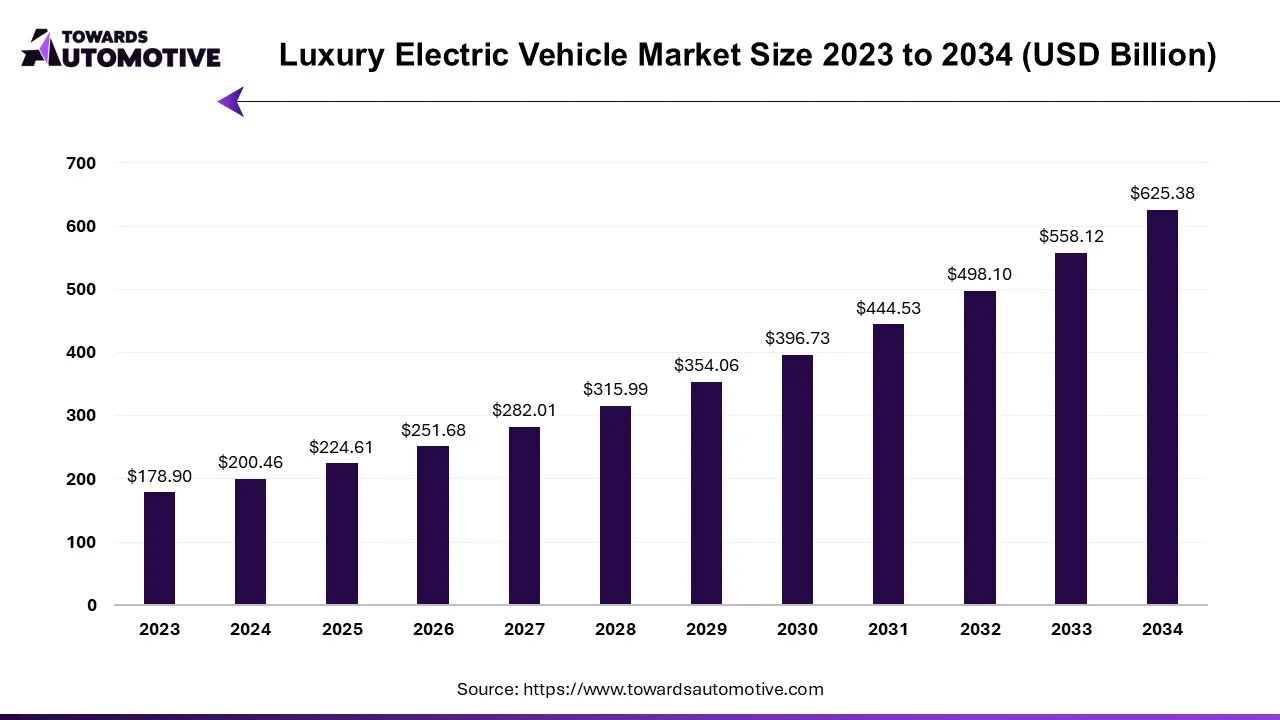
Luxury electric cars represent a fusion of innovation, sophistication, and environmental responsibility, embodying a commitment to cutting-edge technology and sustainability. In recent years, the allure of luxury electric vehicles has been steadily growing, propelled by their reputation as symbols of progress and environmental consciousness.
The global electric vehicle tires market is forecasted to expand from USD 26.81 billion in 2025 to USD 59.59 billion by 2034, growing at a CAGR of 9.28% from 2025 to 2034.
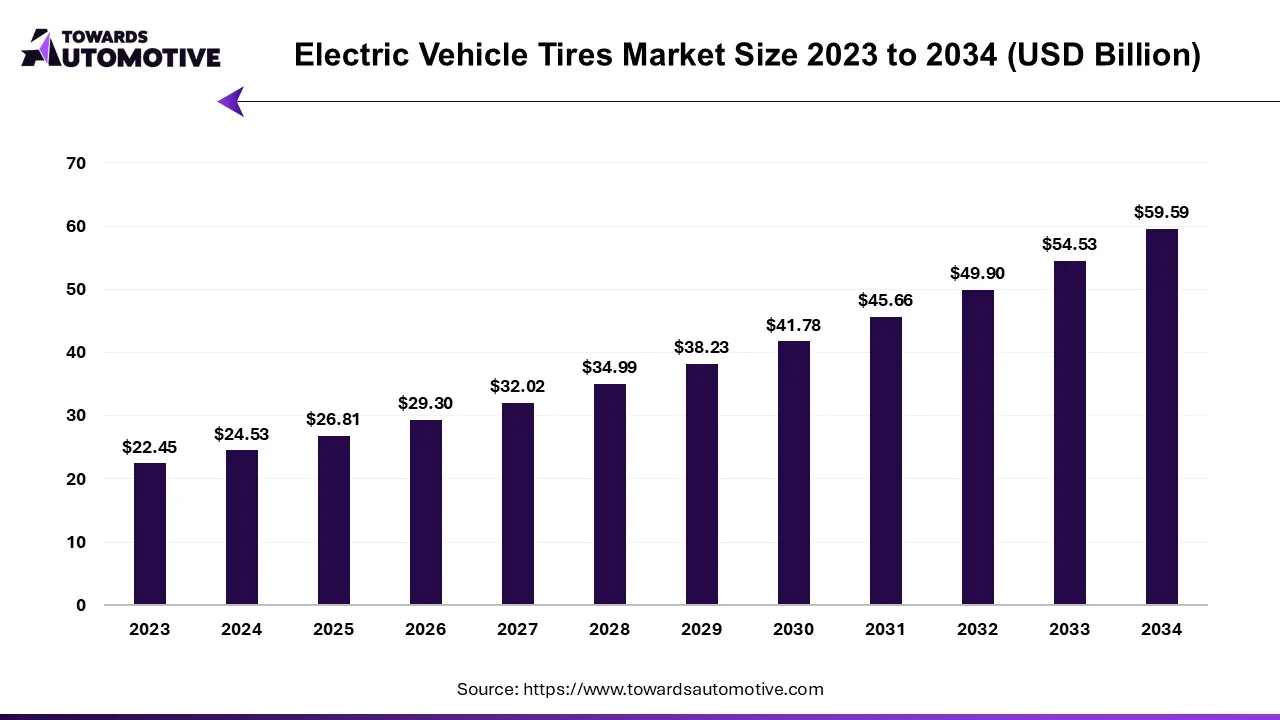
The electric vehicle tires market is a rapidly expanding segment within the automotive industry, driven by the growing adoption of electric vehicles worldwide. EV tires are specifically designed to meet the unique demands of electric vehicles, such as higher torque, heavier weight due to battery packs, and the need for improved energy efficiency to maximize range. These specialized tires play a crucial role in enhancing the overall performance, safety, and longevity of electric vehicles, making them an essential component in the EV ecosystem.
The industrial electric vehicle market is expected to increase from USD 29.08 billion in 2025 to USD 94.49 billion by 2034, growing at a CAGR of 13.99% throughout the forecast period from 2025 to 2034.
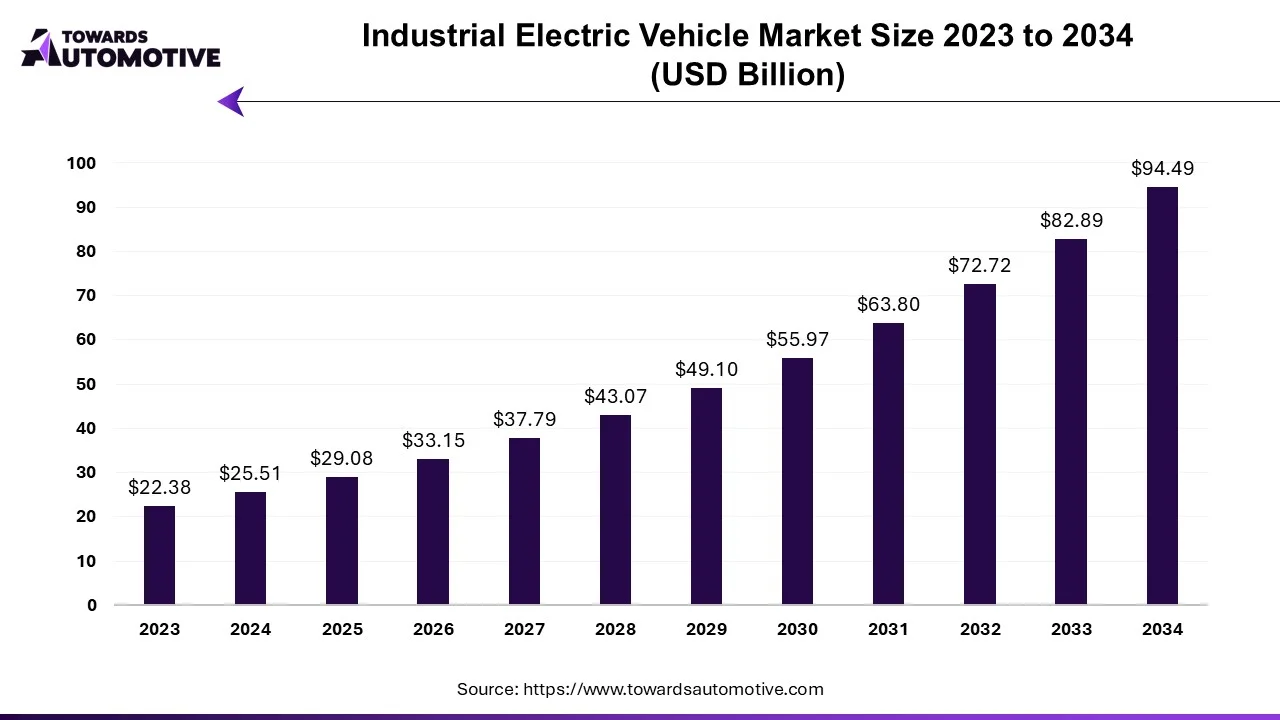
The industrial electric vehicle market is experiencing a remarkable surge, driven by the global shift towards sustainable and efficient transportation solutions in industrial settings. With the advent of advanced battery technology, electric propulsion systems, and digitalization, industrial electric vehicles (IEVs) have emerged as key enablers of productivity, safety, and environmental stewardship across diverse sectors.
The electric vehicle (EV) charger cellular connectivity market is forecasted to expand from USD 2.07 billion in 2025 to USD 11.00 billion by 2034, growing at a CAGR of 20.38% from 2025 to 2034.
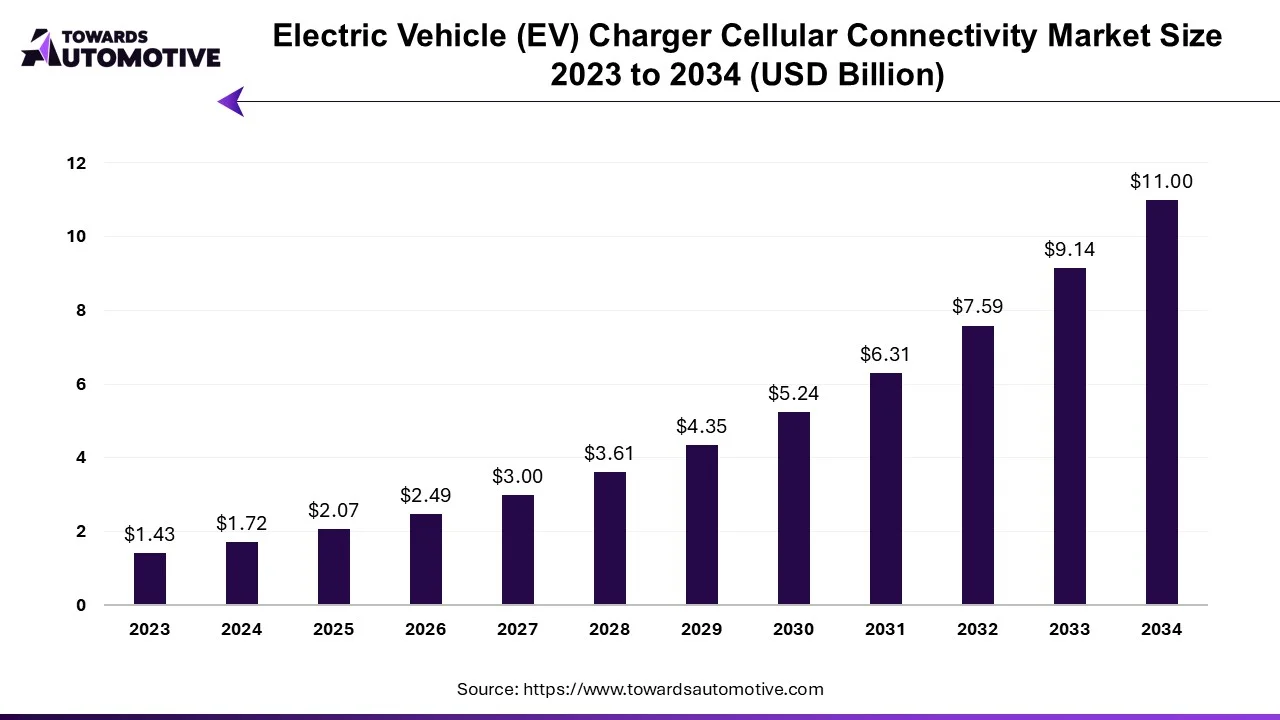
The electric vehicle (EV) charger cellular connectivity market is experiencing remarkable growth, driven by the global transition towards electric mobility, advancements in connectivity technologies, and the increasing demand for efficient charging infrastructure.
The electric vehicle connector market is forecasted to expand from USD 4.05 billion in 2025 to USD 16.91 billion by 2034, growing at a CAGR of 17.20% from 2025 to 2034.
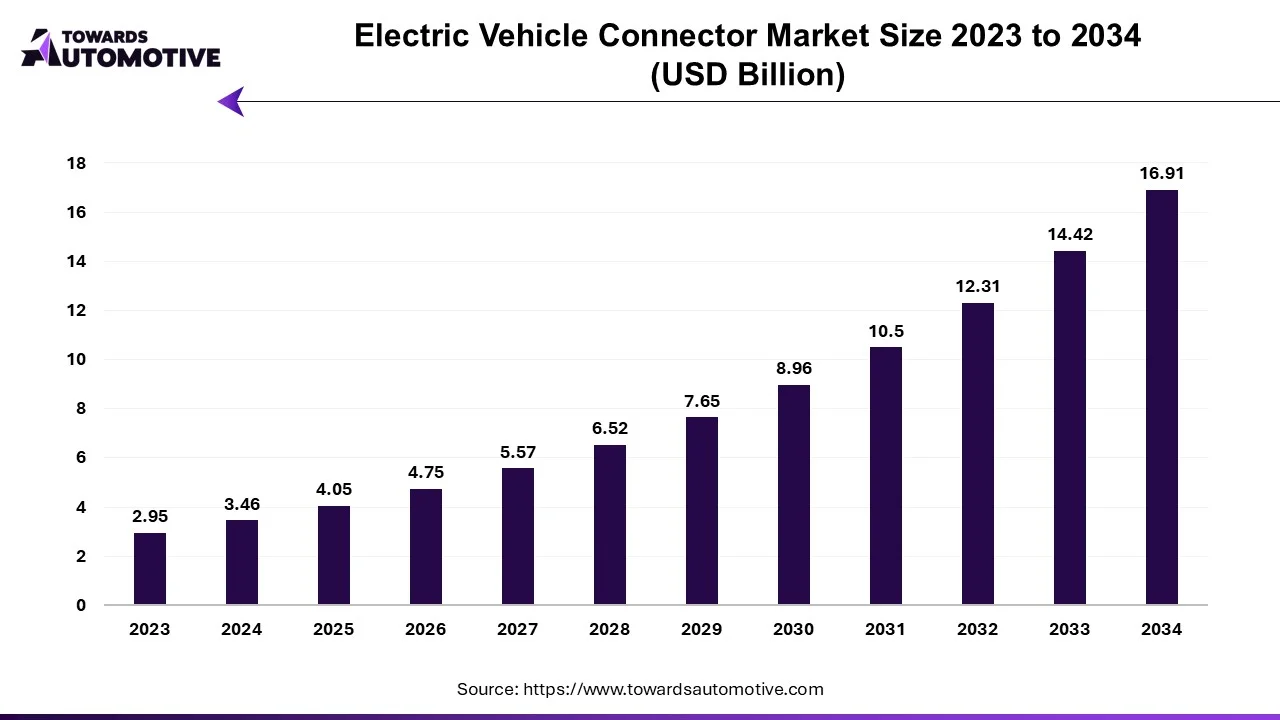
The electric vehicle connector market is experiencing significant growth as the demand for electric vehicles accelerates globally. EV connectors play a crucial role in ensuring efficient and reliable charging by establishing seamless connections between the vehicle and the charging infrastructure. As governments and industries focus on reducing carbon emissions and promoting sustainable transportation, the adoption of electric vehicles is increasing. This, in turn, drives the need for advanced EV connectors that can support faster, safer, and more efficient charging processes. These connectors come in various types, such as AC, DC, and wireless connectors, each catering to specific charging requirements.
The electric vehicle (EV) testing, inspection, and certification market is forecasted to expand from USD 4.65 billion in 2025 to USD 10.32 billion by 2034, growing at a CAGR of 9.25% from 2025 to 2034.
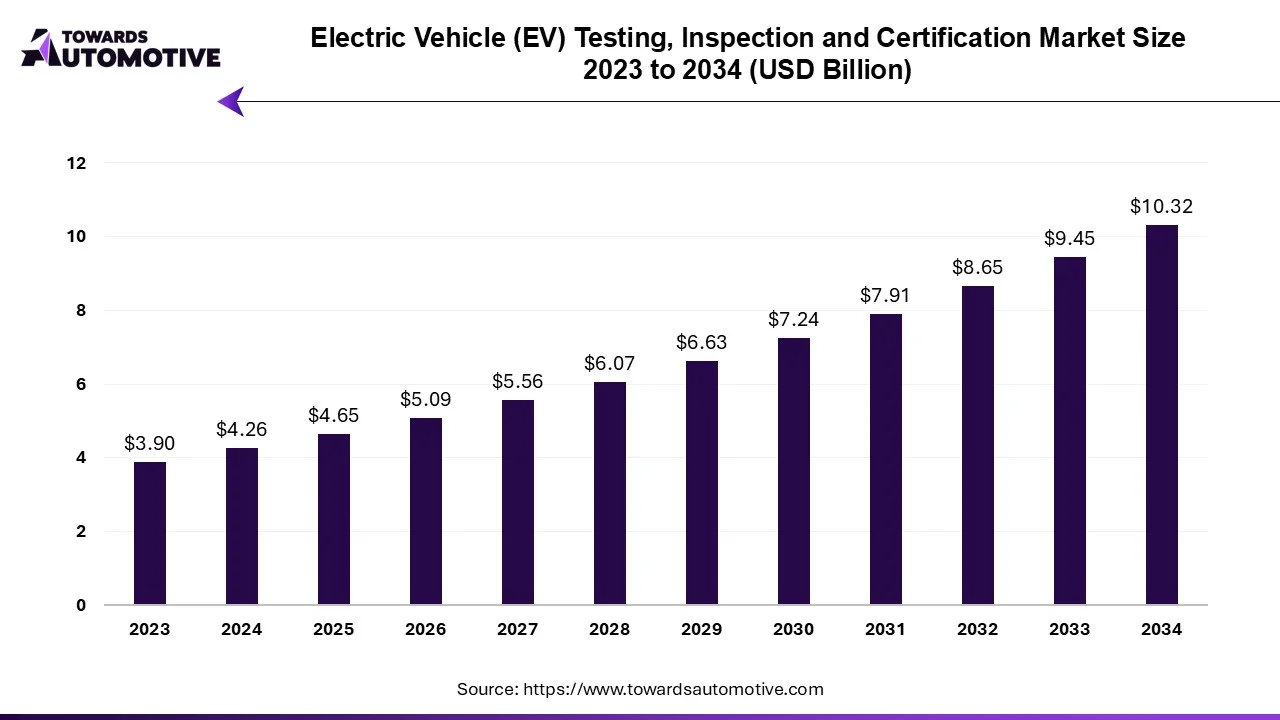
The electric vehicle (EV) testing, inspection, and certification market are witnessing significant growth, driven by the global transition towards electric mobility and the increasing adoption of electric vehicles across various segments. As governments and industry stakeholders prioritize sustainability, safety, and regulatory compliance, the demand for comprehensive testing, inspection, and certification services for EVs continues to rise.
The electric vehicle e-axle market is projected to reach USD 559.06 billion by 2034, growing from USD 17.66 billion in 2024, at a CAGR of 41.27% during the forecast period from 2025 to 2034.
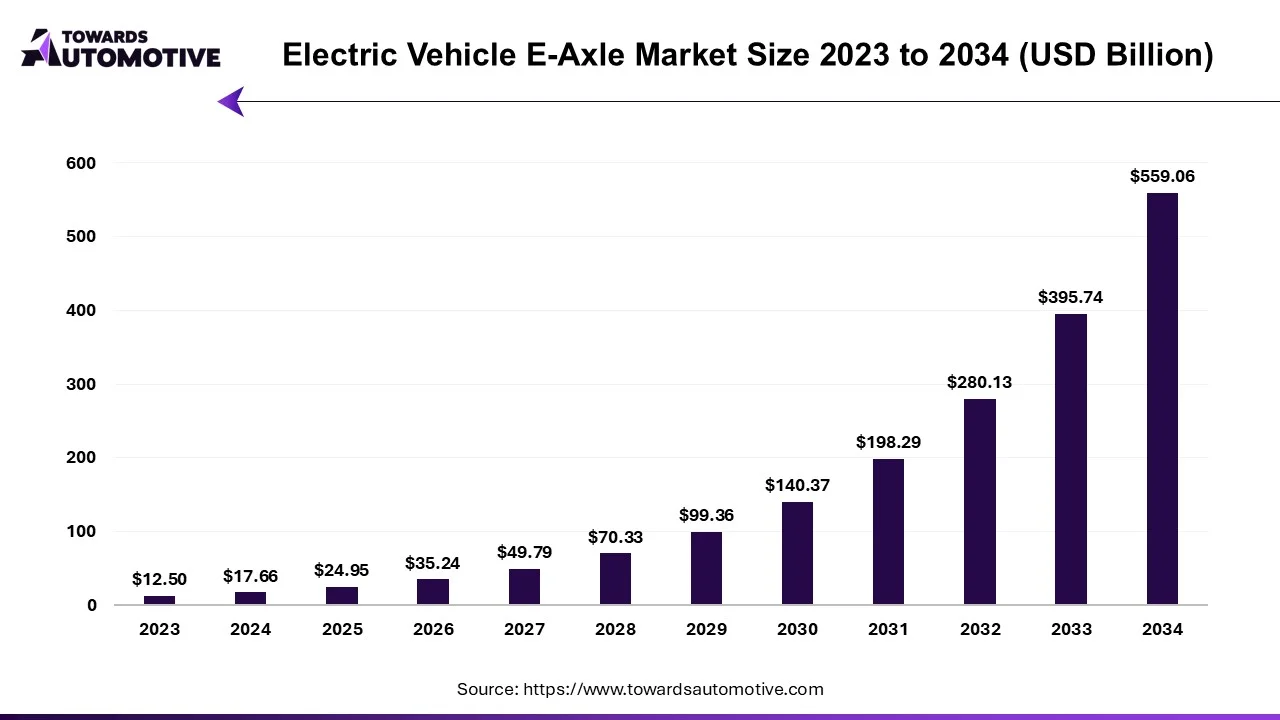
The electric vehicle (EV) e-axle market is experiencing significant growth as the automotive industry shifts toward sustainable mobility solutions. An e-axle, or electric axle, integrates several key components of an electric vehicle's powertrain, including the electric motor, power electronics, and transmission, into a single compact unit. This system is designed to enhance the efficiency, performance, and overall driving experience of electric vehicles. As demand for EVs continues to rise, driven by growing environmental concerns, government regulations, and advancements in EV technology, the e-axle market is poised to play a pivotal role in shaping the future of the automotive sector.
The electric vehicle security system market is forecasted to expand from USD 49.71 billion in 2025 to USD 77.92 billion by 2034, growing at a CAGR of 5.12% from 2025 to 2034.
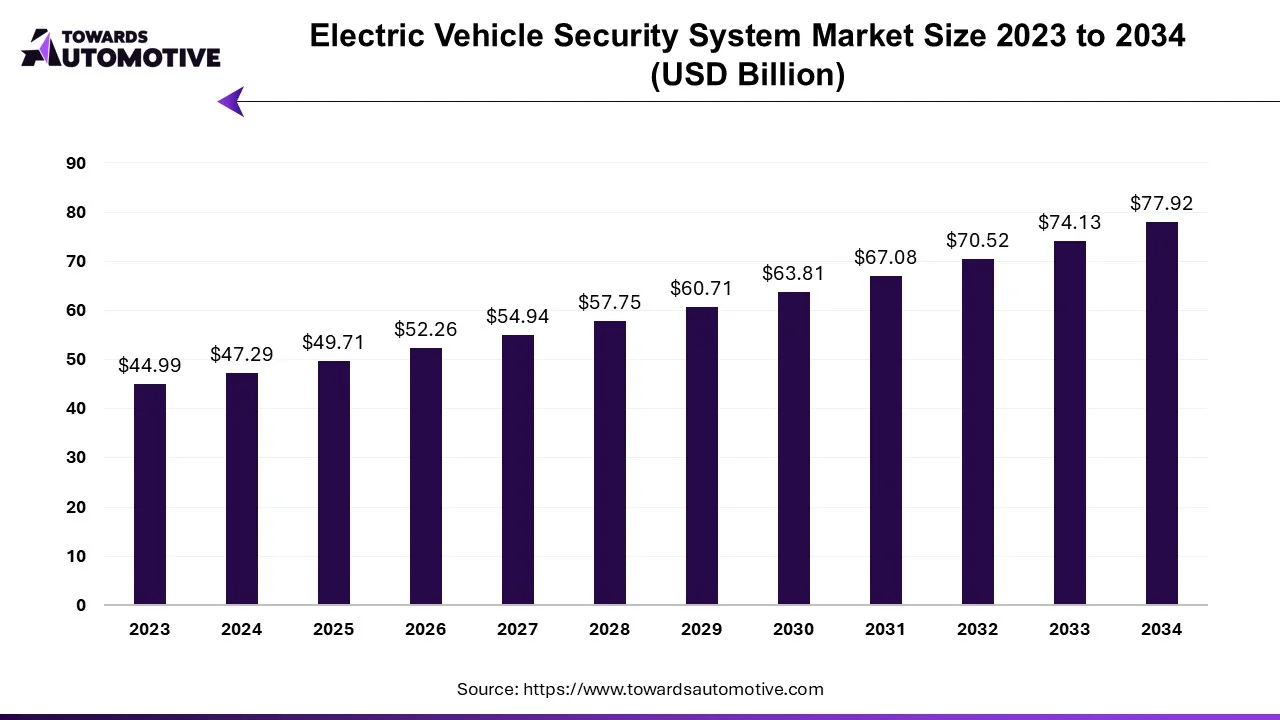
In the medium term, the market is being driven by the production of more vehicles integrated with Advanced Driver Assistance Systems (ADAS), meeting passenger comfort demands, enhancing safety measures, and complying with government security regulations. Furthermore, the increasing acceptance of autonomous or self-driving vehicles is contributing to market expansion.
The electric vehicle motor communication controller market is forecasted to expand from USD 969.45 million in 2025 to USD 3,540.67 million by 2034, growing at a CAGR of 15.48% from 2025 to 2034.
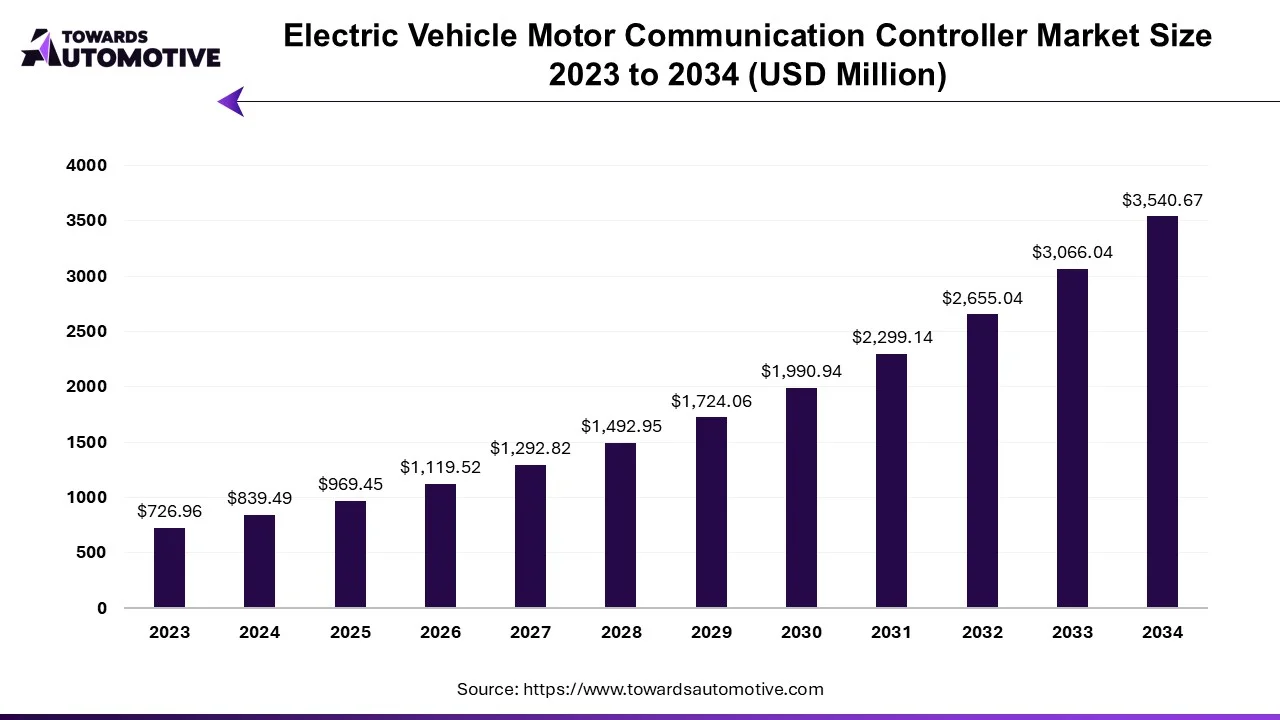
The market for electric vehicle charging infrastructure (EVCI) is being propelled by the rising demand for electric charging solutions, driven in part by increased financial incentives provided by governments worldwide. Various governments, such as India's, have initiated programs like the Adoption and Manufacturing of Electric Vehicles in India (FAME India) program to incentivize the purchase of electric vehicles by offering subsidies. This has led to a surge in demand for electric vehicle supply equipment (EVSE), particularly for large-scale charging centers, as businesses in sectors like transportation, logistics, and fast-moving consumer goods (FMCG) invest in electric fleets.
The wireless charging electric vehicle market is anticipated to grow from USD 457.14 million in 2025 to USD 3,433.07 million by 2034, with a compound annual growth rate (CAGR) of 37.06% during the forecast period from 2025 to 2034.
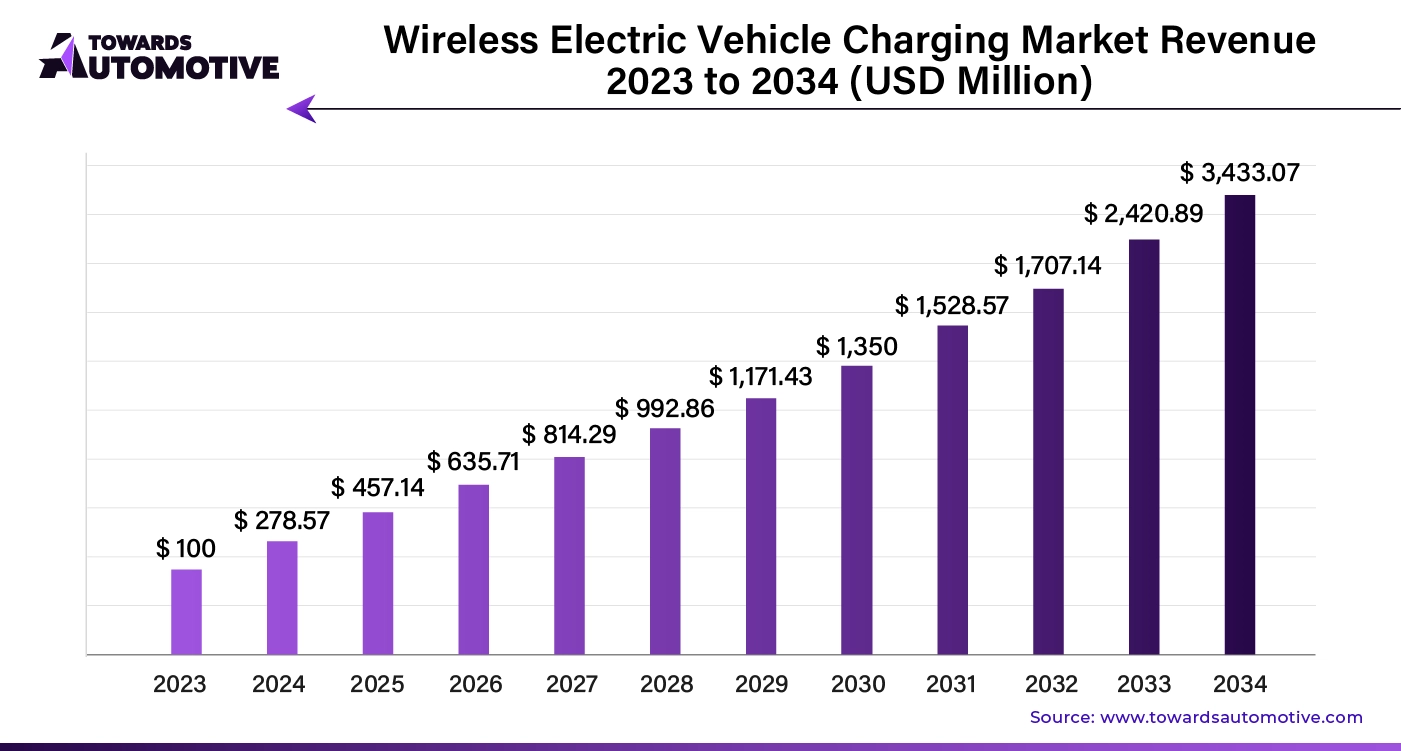
The wireless charging electric vehicle market is a crucial segment of the automotive industry. This industry deals in manufacturing and distribution of wireless charging solutions for EVs around the world. The wireless chargers are integrated with different technologies including magnetic field charging, inductive charging, resonant inductive charging and others. These chargers are designed for numerous types of vehicles consisting of passenger vehicles, light commercial vehicles, heavy commercial vehicles and others. The end-user of this industry comprises of individual consumers, fleet operators, government and municipalities. The growing sales of EVs in different parts of the globe has contributed to the overall expansion of the industry. This market is likely to rise drastically with the growth of the electric vehicle industry in different parts of the world.
The automotive high-performance electric vehicles market is projected to reach USD 491.41 billion by 2034, growing from USD 203.53 billion in 2025, at a CAGR of 10.29% during the forecast period from 2025 to 2034.
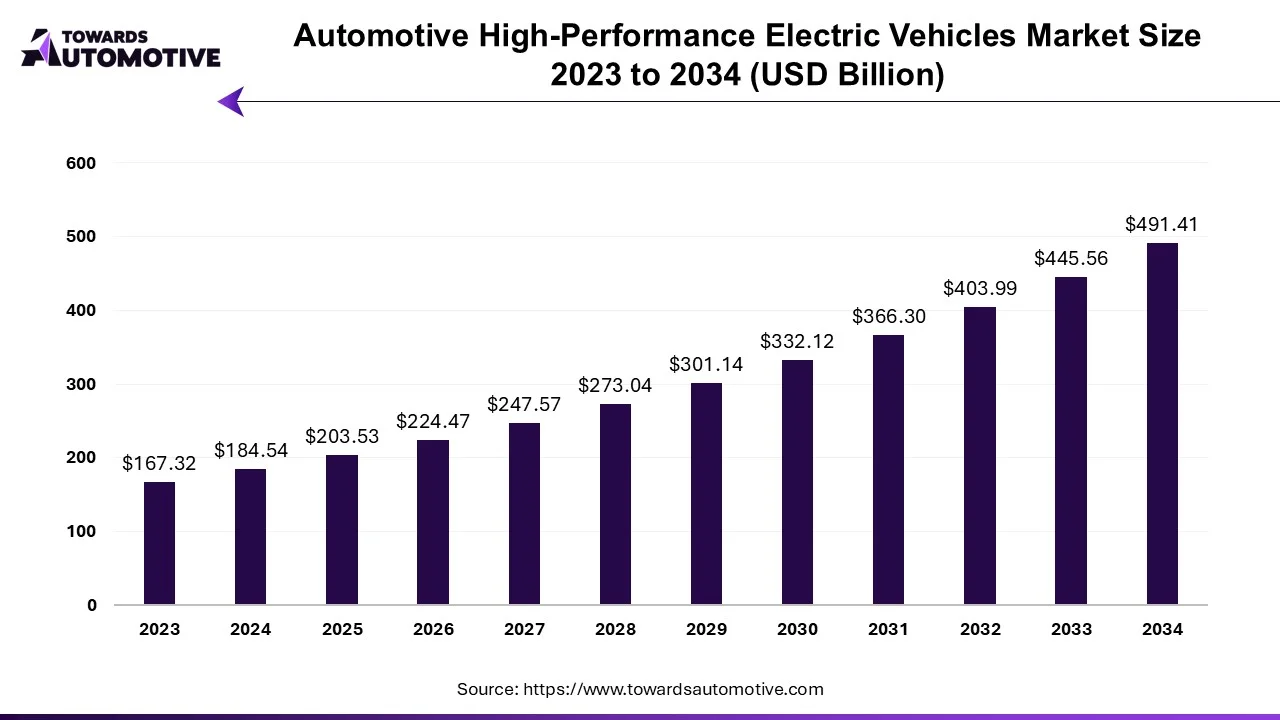
The global electric vehicle motor market is anticipated to grow from USD 24.58 billion in 2025 to USD 143.85 billion by 2034, with a compound annual growth rate (CAGR) of 21.69% during the forecast period from 2025 to 2034. The market is driven by the rapid penetration of electric vehicles (EV), government policies to promote EVs, and growing investment by automotive brands.

The electric vehicle motor market is experiencing rapid growth due to the rising adoption of electric vehicles globally. As governments implement stringent emission regulations and promote sustainable transportation, the demand for efficient and reliable electric motors for EVs is surging at a rapid pace. The increasing focus on reducing greenhouse gas emissions is driving further innovation in electric motor designs. These innovations include improvements in efficiency, power density, and thermal management.
The global electric vehicle battery market is anticipated to grow from USD 106.18 billion in 2025 to USD 370.77 billion by 2034, with a CAGR of 21.50% during the forecast period from 2025 to 2034.

The electric vehicle battery market is experiencing rapid growth, driven by the increasing global adoption of electric vehicles as part of the transition toward cleaner, more sustainable transportation. EV batteries are a critical component of electric vehicles, powering everything from passenger cars to commercial trucks, and their performance directly impacts vehicle range, efficiency, and cost. As governments worldwide implement stricter emissions regulations and provide incentives for EV adoption, the demand for advanced, high-capacity batteries has surged.
The electric vehicles market is a highly fragmented industry with the presence of several dominating players. Some of the prominent companies in this industry consists of Mitsubishi Motors Corporation; Nissan Motor Co., Ltd.; AB Volvo; Kawasaki Motors Corp. U.S.A; Mercedes-Benz Group AG; BYD Company Ltd.; Ford Motor Company; General Motors; Lucid Motors; Honda Motor Co., Ltd.; Renault Group; Tesla Inc.; Toyota Motor Corporation; Volkswagen Group; Rivian, Zero Motorcycle and some others. These companies are constantly engaged in developing electric vehicles and adopting numerous strategies such as launches, partnerships, joint ventures, acquisitions, business expansions, collaborations and some others to maintain their dominance in this industry.
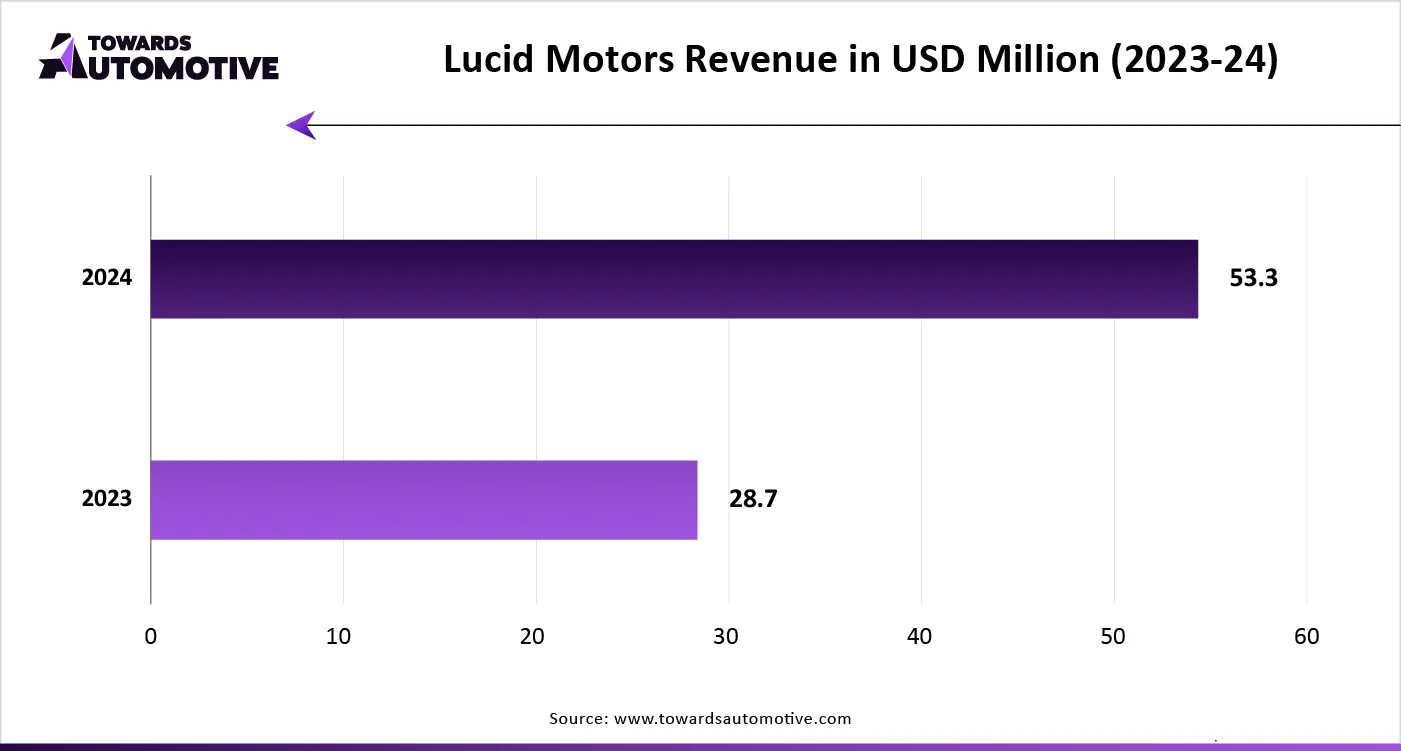
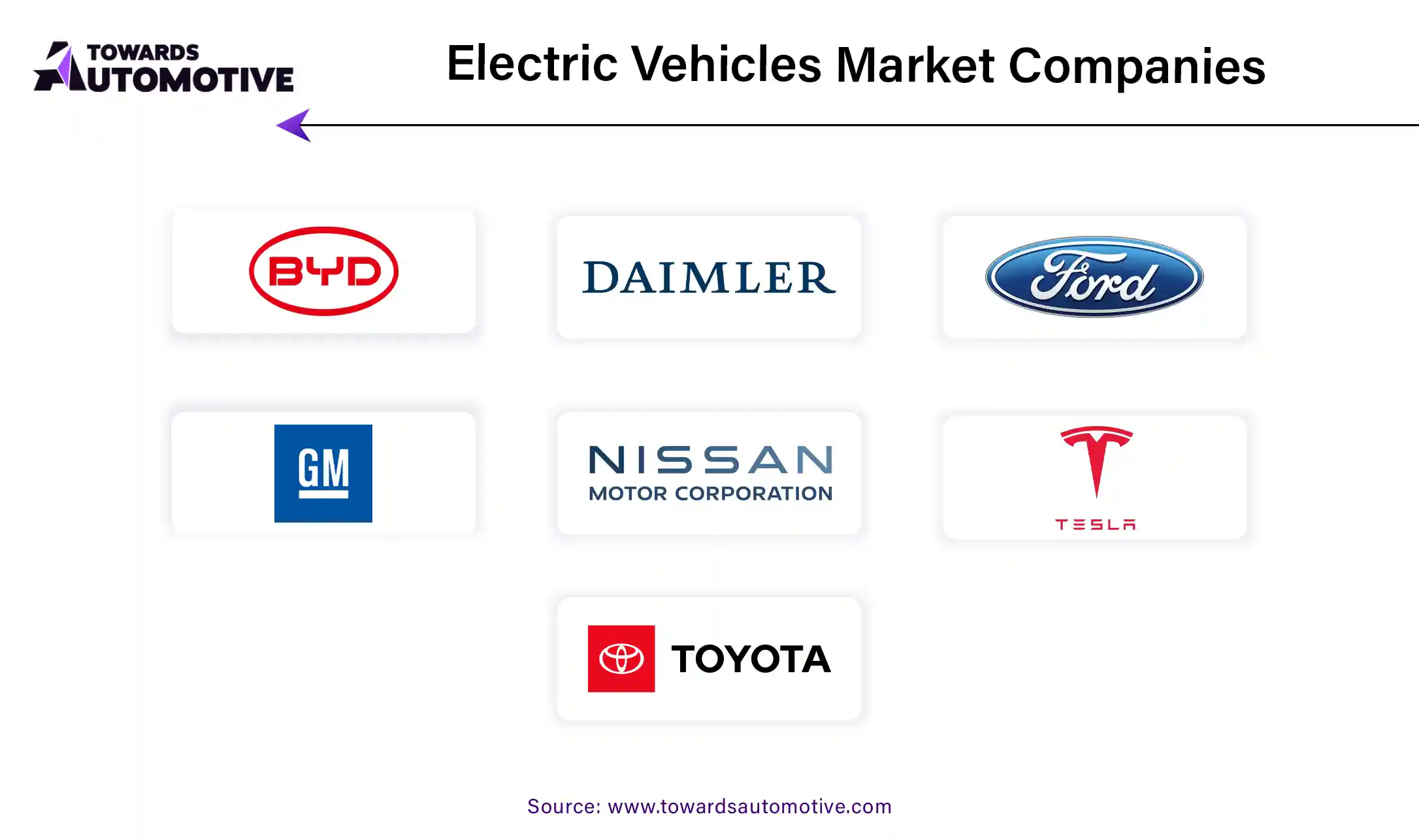
By Vehicle Type
By Propulsion Type
By Drive Type
By Vehicle Speed
By Vehicle Class
By End Use
By Region
October 2025
October 2025
October 2025
October 2025
We offer automotive expertise for market projections and customizable research, adaptable to diverse strategic approaches.
Contact Us